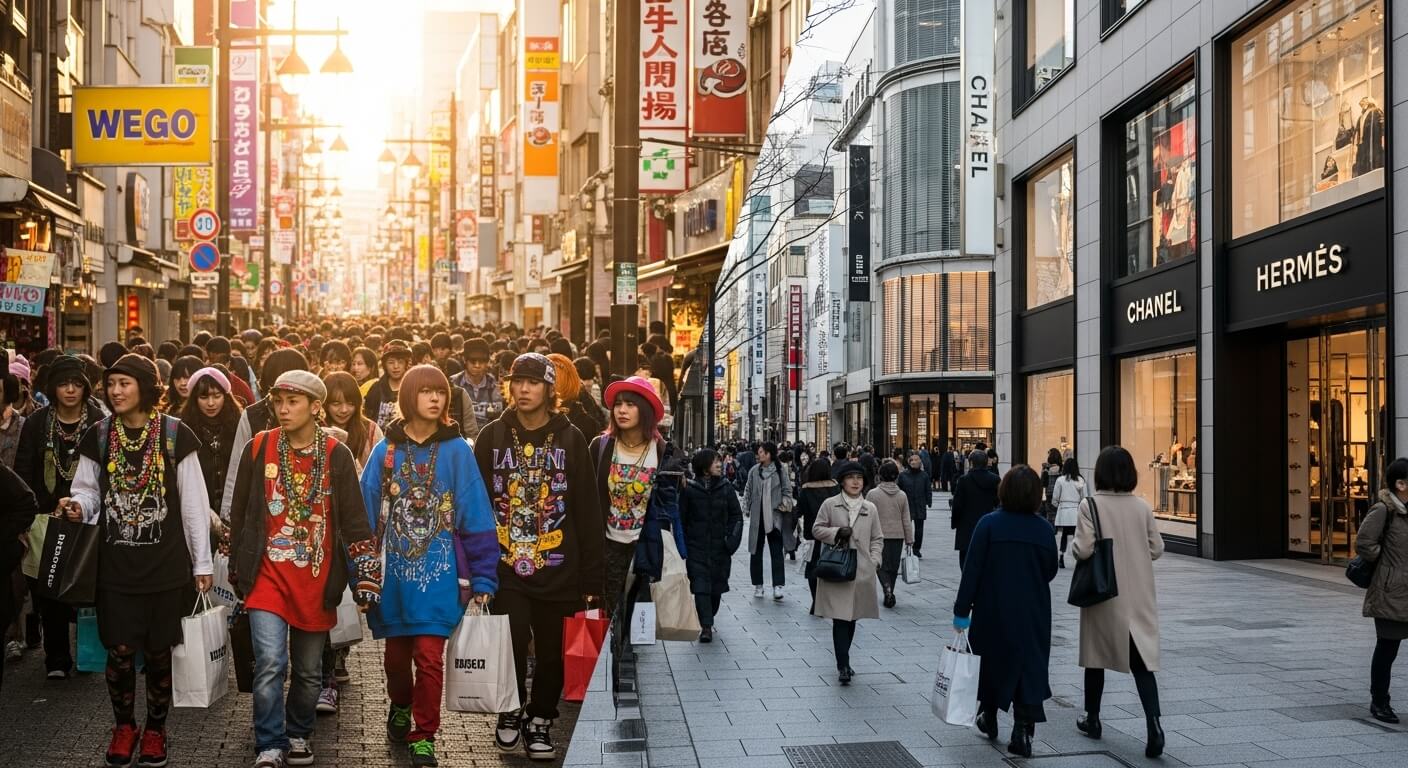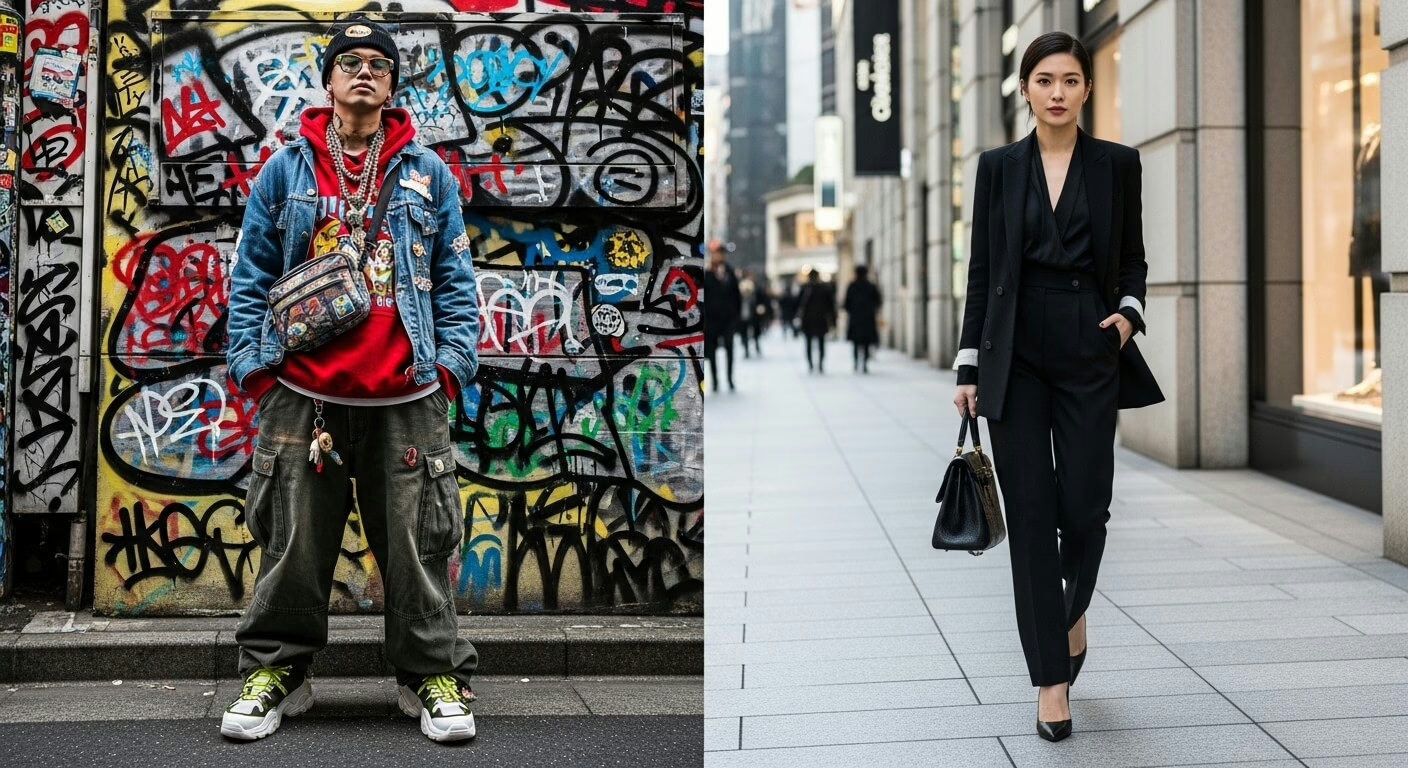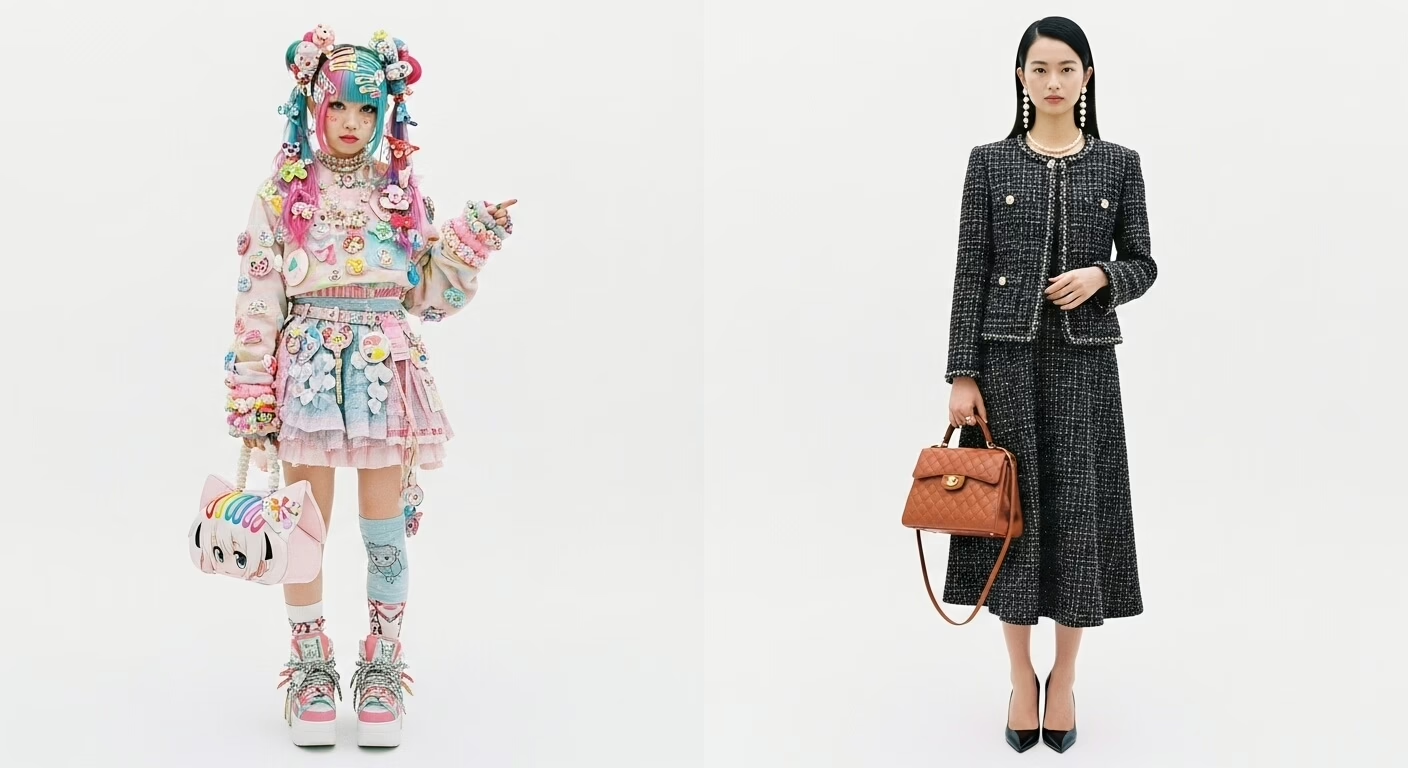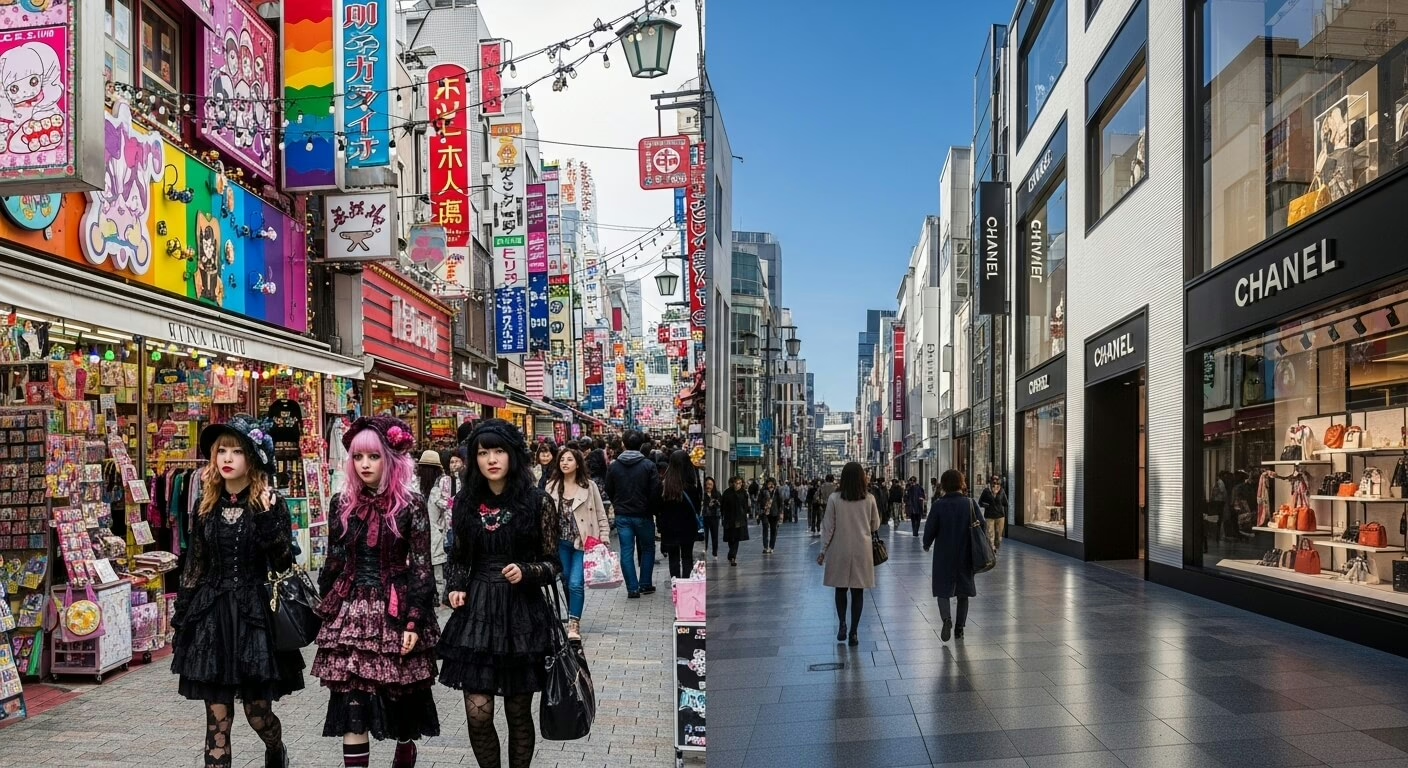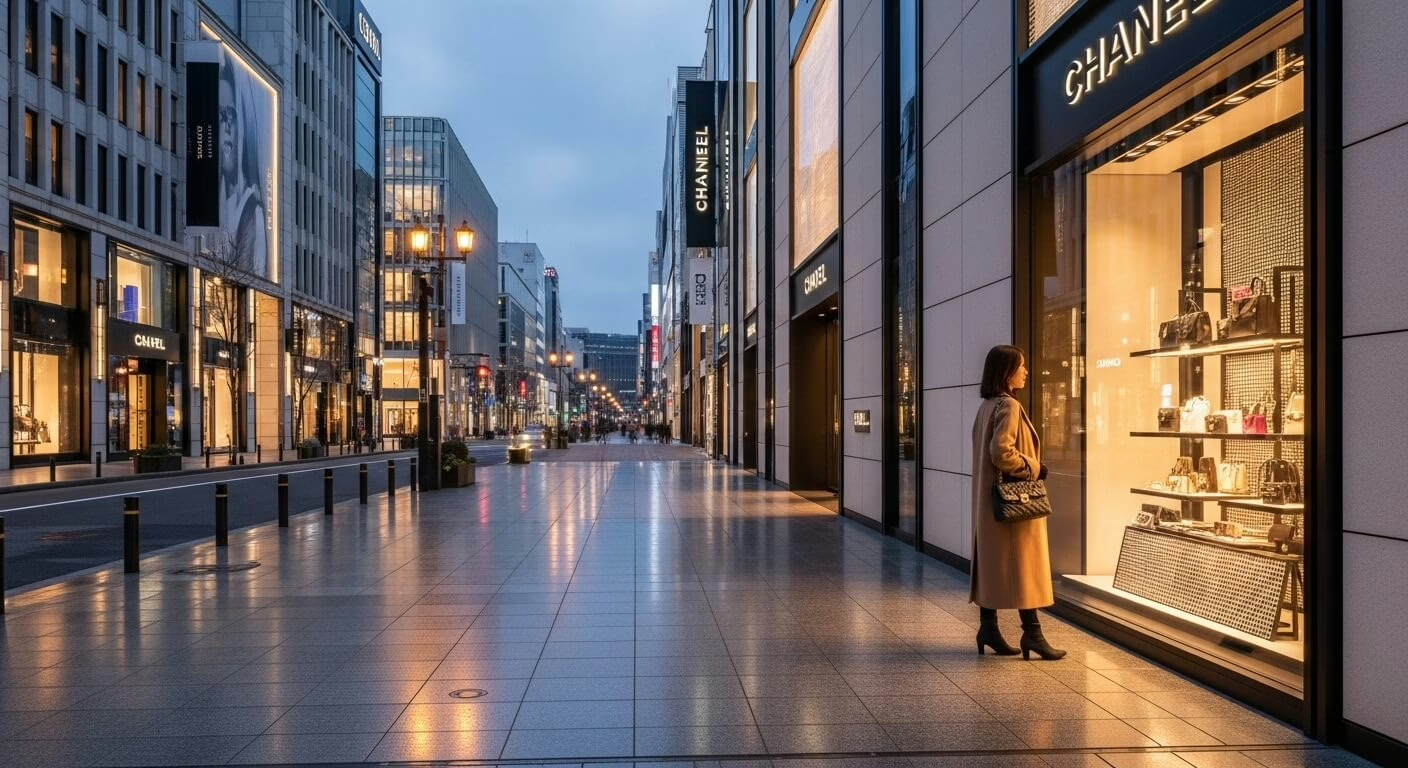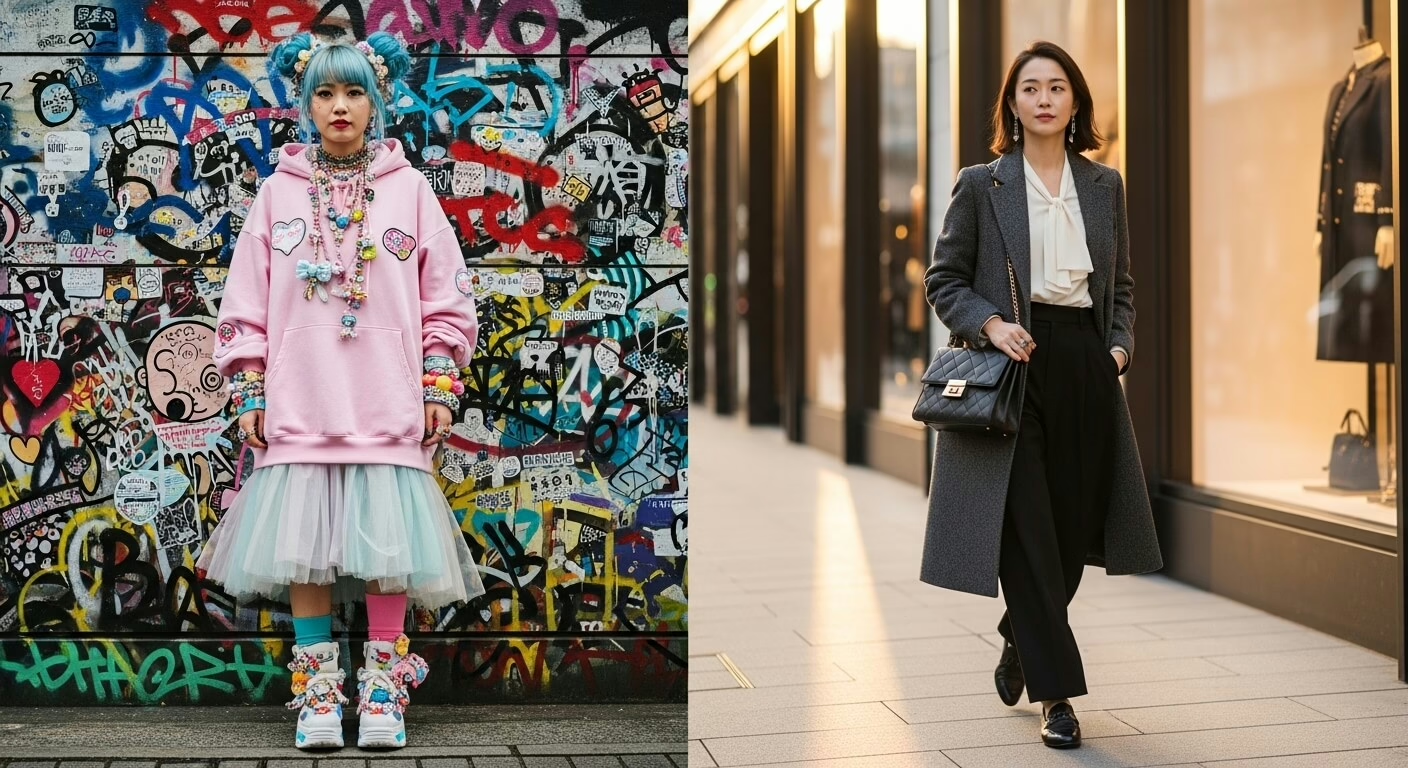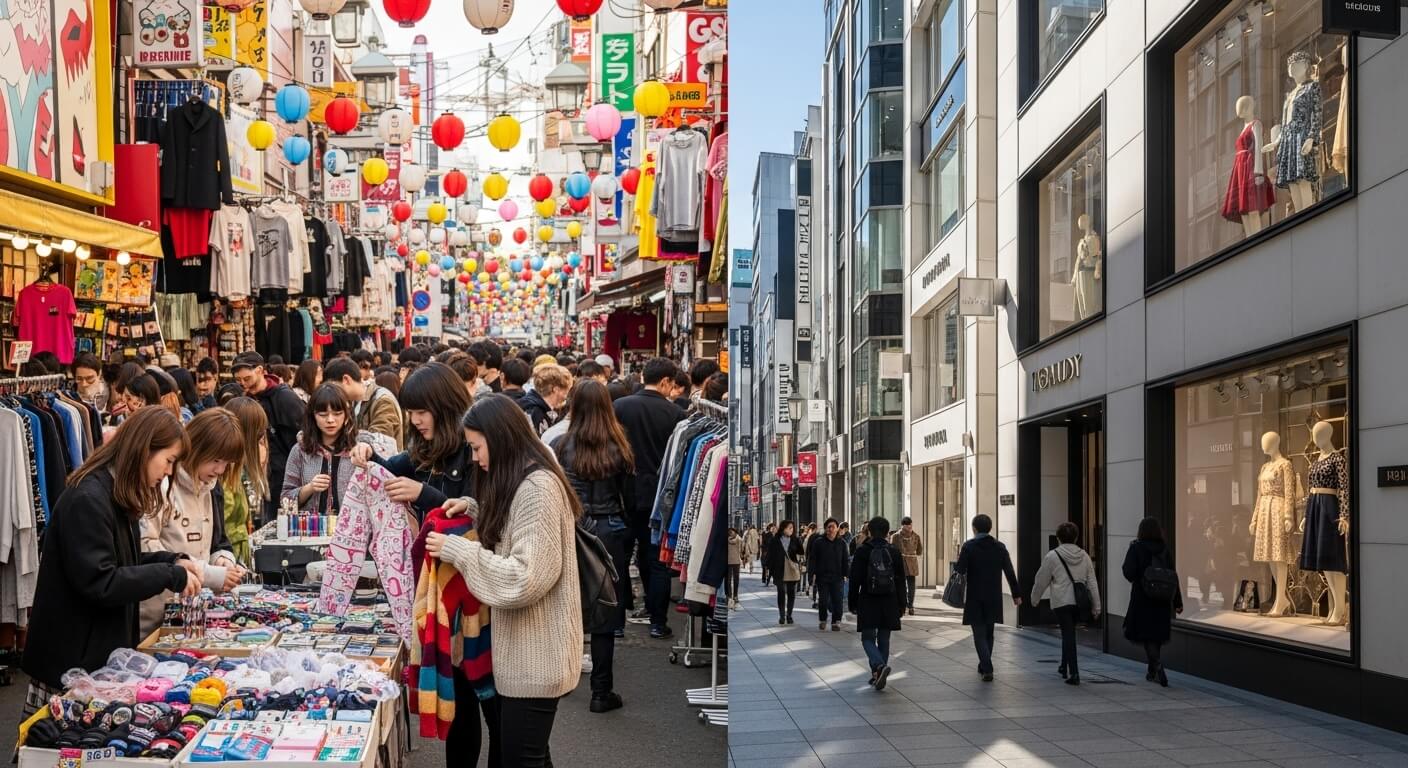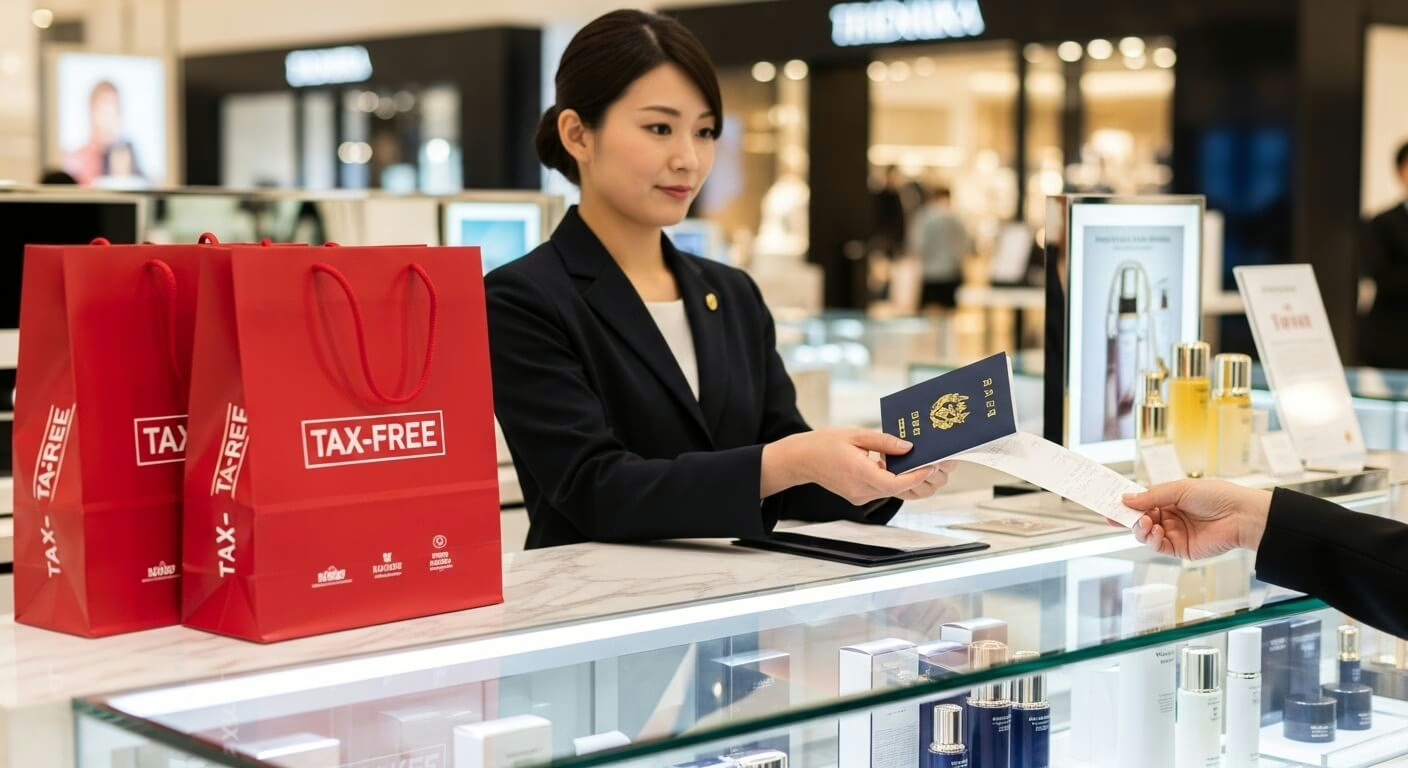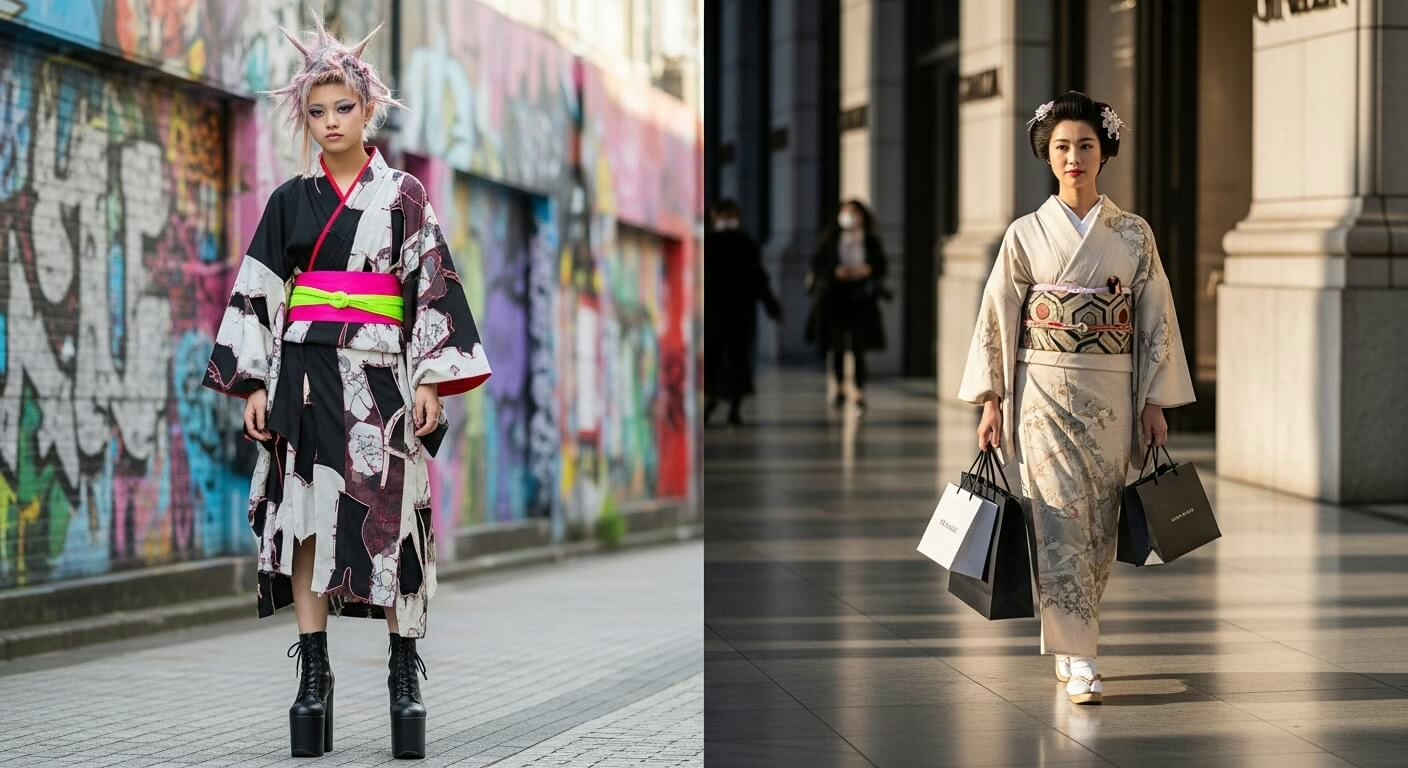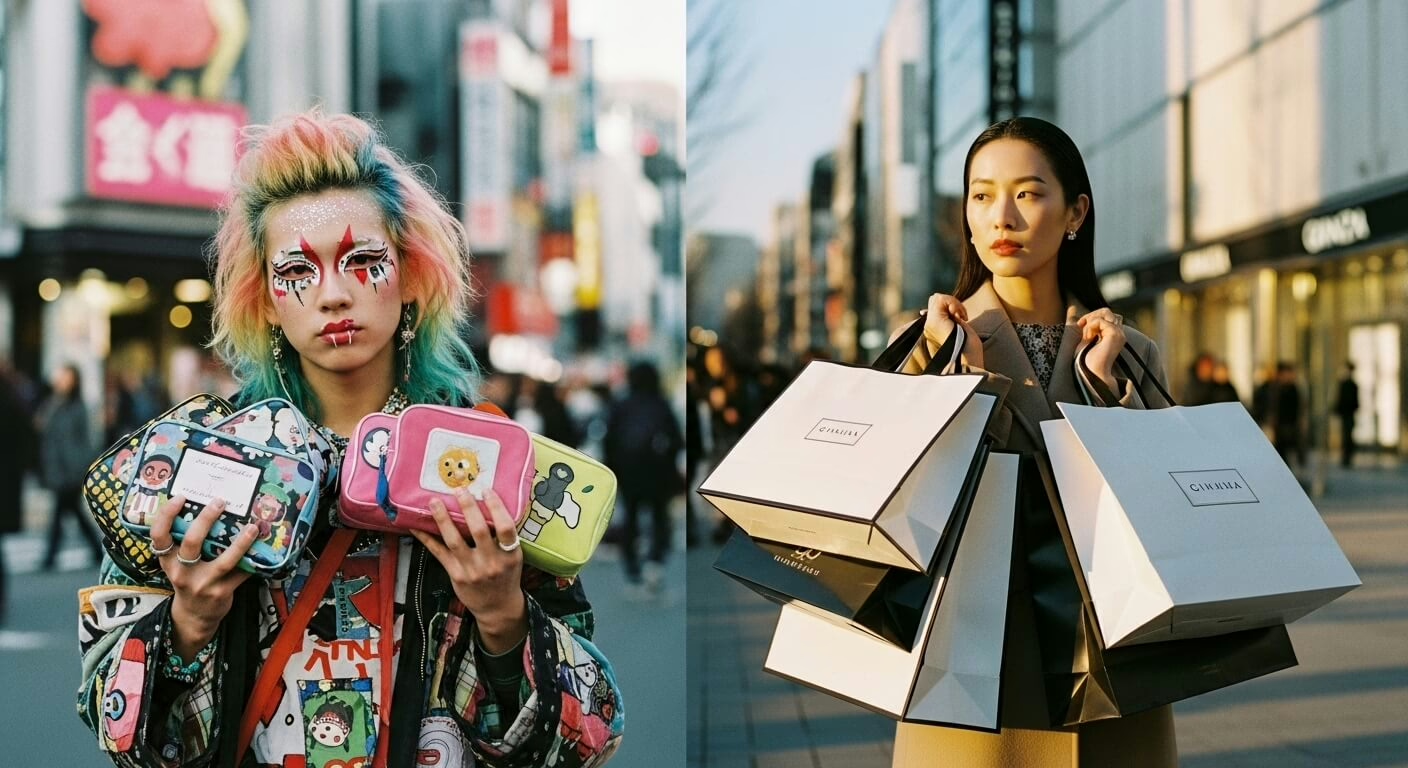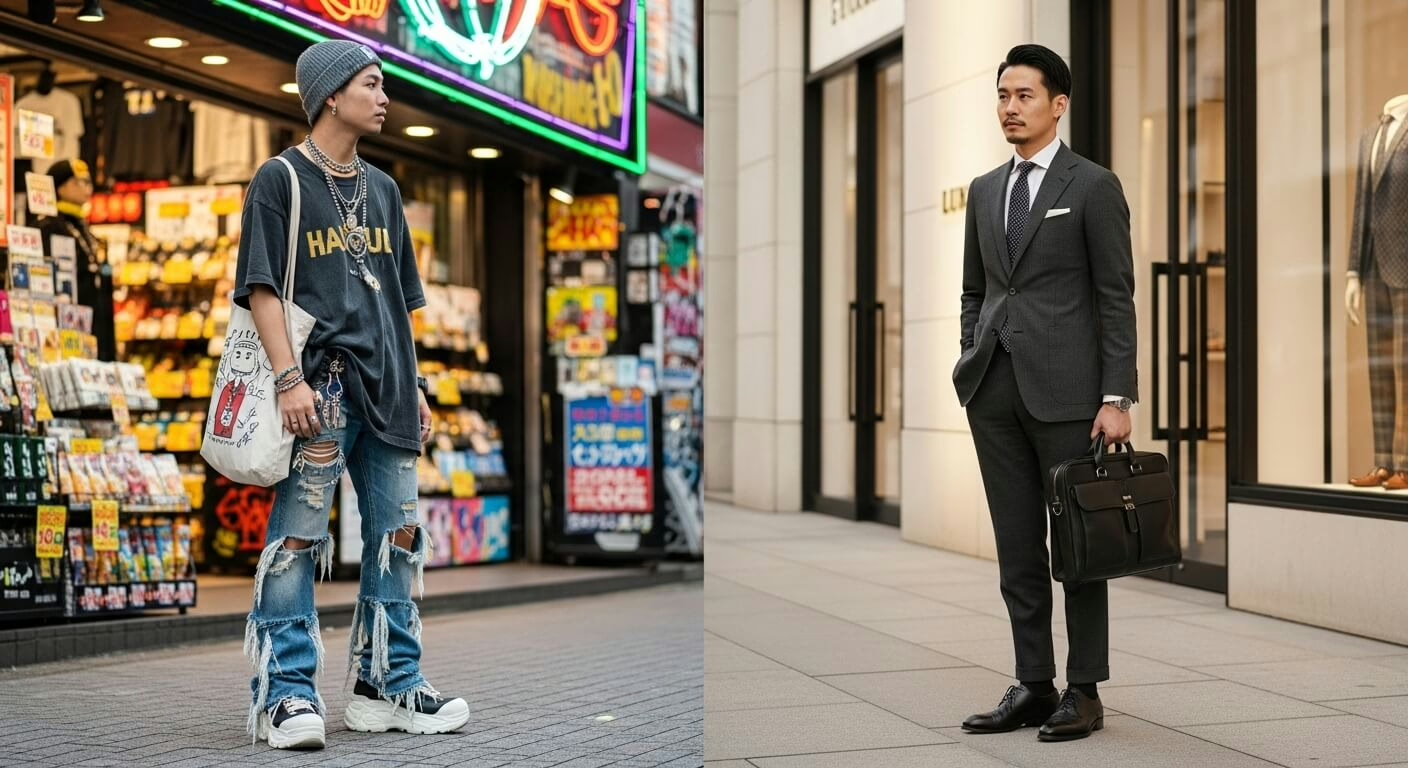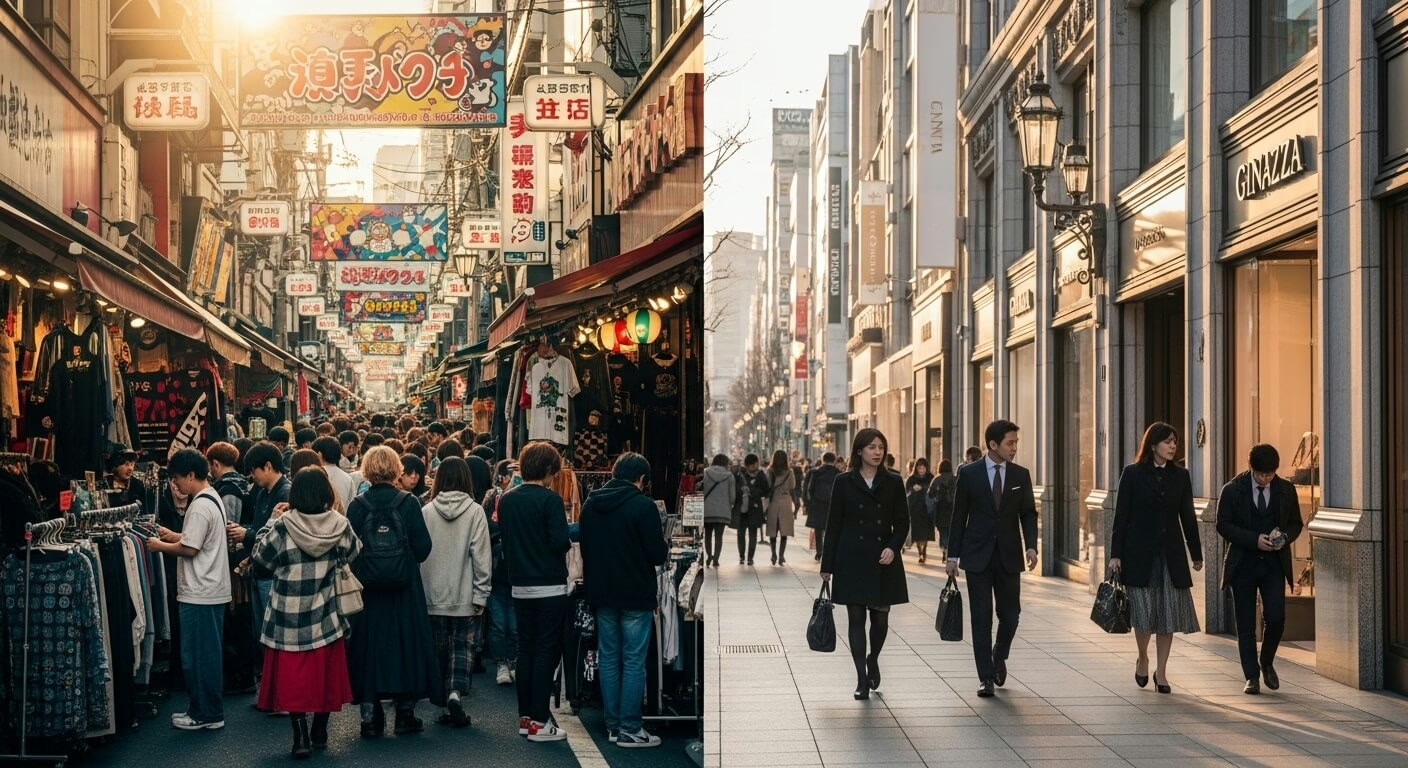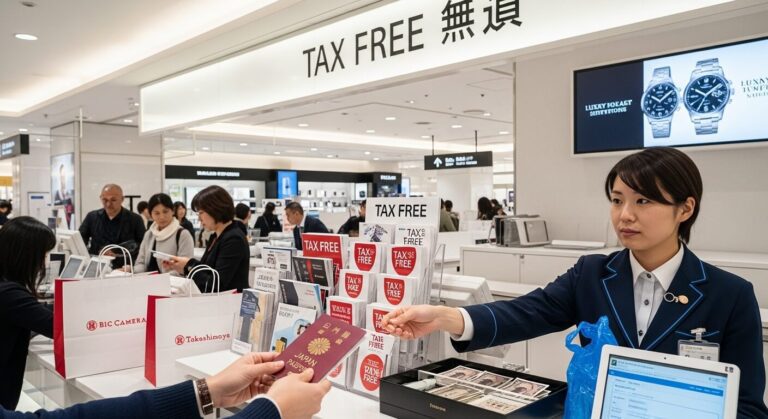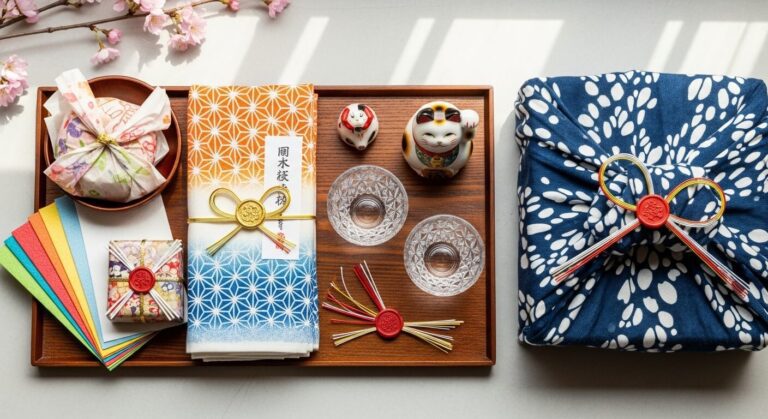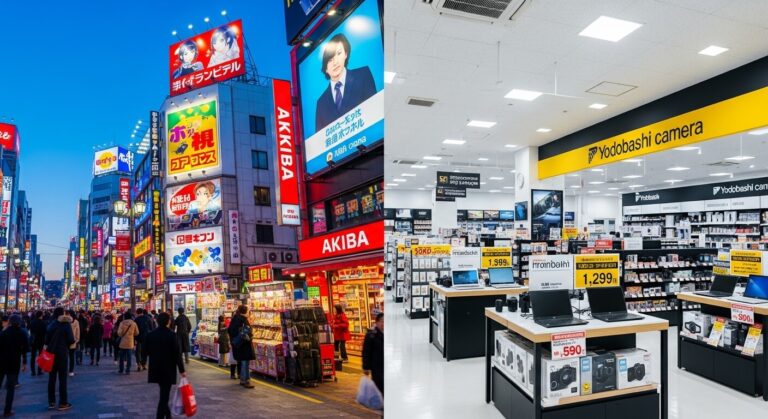Tokyo Fashion Shopping: Harajuku vs. Ginza Style Districts
Tokyo Fashion Shopping: Complete Harajuku vs. Ginza Comparison – Tokyo’s fashion scene splits into two distinct worlds just four subway stops apart—Harajuku thrives on rebellious youth culture with vintage finds starting at ¥500 and streetwear collaborations, while Ginza showcases architectural luxury flagships where pieces begin around ¥800,000.
Harajuku’s Takeshita Street, Cat Street, and Omotesando attract sneakerheads and trendsetters hunting emerging Japanese designers, whereas Ginza draws established professionals seeking Comme des Garçons, Hermès, and immersive art museum-like shopping experiences.
The districts offer completely different atmospheres—electric chaos versus sleek sophistication—with timing, budget, and style preferences determining which fashion universe suits individual explorers best.
Key Takeaways
Hide- Harajuku offers eclectic street style with vintage finds and emerging designers, while Ginza features luxury brands and architectural flagship stores.
- Harajuku prices range from ¥500-¥5,000 for trendy pieces; Ginza focuses on premium shopping with items starting at ¥800,000.
- Harajuku attracts teenagers and young adults experimenting with fashion; Ginza draws established professionals seeking high-end craftsmanship.
- Harajuku splits into Takeshita Street's vibrant chaos, Cat Street's indie boutiques, and Omotesando's designer flagships.
- Visit Harajuku early mornings on weekdays for vintage restocks; explore Ginza's architectural landmarks and tax-free shopping on quieter weekdays.
Tokyo Fashion Districts Decoded: Harajuku’s Street Style vs. Ginza’s Luxury Scene
While both neighborhoods sit within Tokyo’s sprawling metropolis, Harajuku and Ginza couldn’t be more different in their fashion DNA—one pulses with rebellious youth culture and experimental street style, while the other gleams with flagship boutiques and price tags that make wallets weep.
Tokyo Trip Add-Ons
Equip yourself for the ultimate Tokyo adventure with the following add-ons, curated just for you.
Harajuku thrives on cultural influences from anime, K-pop, and underground subcultures, where teens layer vintage tees with platform sneakers and gravity-defying accessories.
Seasonal trends here shift faster than you can say “kawaii,” with Takeshita Street vendors constantly rotating stock based on what’s trending on Instagram.
Ginza, meanwhile, embodies timeless elegance through Chanel, Hermès, and Dior storefronts where personal shoppers guide you through curated collections.
This district respects seasonal trends through haute couture lens—think spring pastels executed in silk, not polyester.
Two Fashion Worlds in One City; Tokyo
Tokyo’s fashion scene operates like two parallel universes that somehow coexist within a few subway stops—on one side, Harajuku’s kaleidoscope of experimental youth culture where vintage band tees meet avant-garde streetwear, and on the other, Ginza’s polished boutiques where elegance comes with a capital E (and a price tag to match).
Your ¥10,000 might score you an entire coordinated outfit in Shimokitazawa’s vintage shops, but in Ginza’s department stores, that same amount barely covers a designer handkerchief.
The demographics tell the whole story: teenage trendsetters with rainbow hair prowl Takeshita Street hunting for the next Instagram moment, while sophisticated professionals in tailored suits browse Chanel and Hermès during their lunch breaks, each group existing in their own sartorial dimension.
Youth Culture vs. Established Elegance: The Split Personality
Few cities on Earth showcase such a dramatic fashion dichotomy as Tokyo, where cutting-edge youth subcultures and refined traditional elegance don’t just coexist—they thrive in completely separate universes just blocks apart.
Harajuku pulses with streetwear origins rooted in rebellion and self-expression, while Ginza glitters with timeless sophistication that commands respect through quiet confidence.
These districts represent opposing philosophies that somehow enhance rather than diminish each other.
The stark contrast manifests in three unmistakable ways:
- Price points: Harajuku’s vintage finds versus Ginza’s luxury boutiques
- Demographics: Teenagers experimenting with identity versus established professionals investing in quality
- Cultural influences: Global street trends mixing with Japanese anime aesthetics versus European heritage brands
This split personality defines Tokyo’s fashion landscape, offering you total freedom to choose your tribe—or fearlessly explore both!
Price Point Reality: What Your Budget Gets You Where
Your wallet will experience whiplash traversing Tokyo’s fashion districts, where ¥500 ($3.50) can score a quirky vintage tee in Shimokitazawa but won’t even cover parking in Omotesando.
Harajuku transforms the vintage treasure hunt into an art form—think ¥2,000-¥5,000 ($14-$35) for statement pieces at WEGO or Santa Monica, while Takeshita Street hawks accessories under ¥1,000.
Meanwhile, Ginza’s department stores like Mitsukoshi showcase Chanel blazers starting at ¥800,000 ($5,600), though their basement floors offer surprisingly affordable Japanese cosmetics.
Here’s your freedom: achieving luxury on a budget means strategically mixing districts.
Snag accessories in Harajuku’s backstreets, then anchor your look with one investment piece from Ginza’s seasonal sales, where designer goods drop 50-70% each January and July!
Who Shops Where: Demographics and Style Tribes
While twentysomething art students in oversized vintage band tees cluster around Shimokitazawa’s thrift shops every Saturday afternoon, their age-equivalent corporate climbers browse Ginza’s Uniqlo flagship in perfectly pressed business casual—proof that Tokyo doesn’t just segment shoppers by neighborhood, but creates entirely parallel fashion universes.
Youth tribes stake territorial claims across districts:
- Harajuku attracts experimental teens mixing Comme des Garçons with secondhand finds, creating outfits that’d make their salary-worker parents gasp
- Ginza belongs to established professionals who treat luxury brands like career investments, not Instagram props
- Shimokitazawa draws creatives in their thirties who’ve outgrown Harajuku’s chaos but refuse corporate conformity
Each district functions as its own ecosystem, where age, income, and attitude determine which marble floors or concrete steps you’ll naturally gravitate toward!
Harajuku’s Fashion Identity and Evolution
Harajuku has evolved from a single teenage rebellion hotspot into three distinct fashion ecosystems, each serving a completely different crowd.
Takeshita Street still packs in the tourists hunting kawaii culture and cheap accessories, but savvy shoppers know that Cat Street’s curated boutiques and Omotesando’s tree-lined luxury avenue offer entirely different vibes just minutes away.
Understanding which Harajuku matches your style—budget chaos, streetwear cool, or high-end sophistication—makes the difference between buying another generic souvenir and scoring pieces that actually define your wardrobe.
Takeshita Street: Tourist Central but Still Worth It
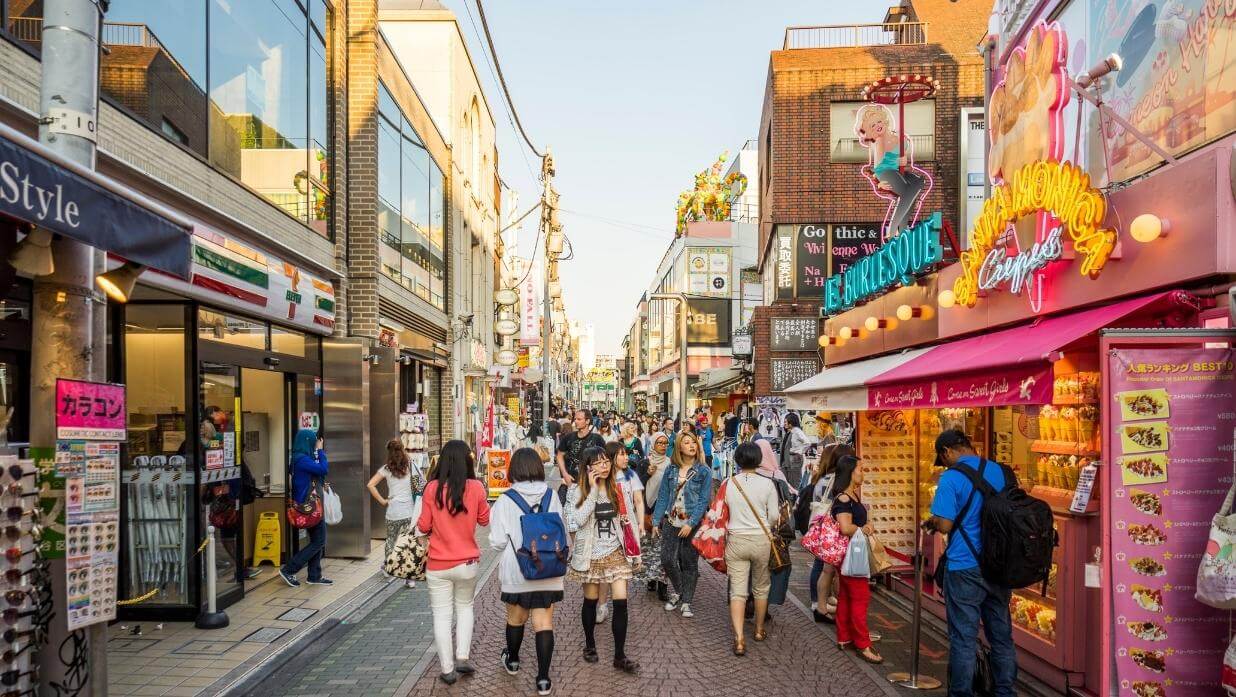
Takeshita Street throws you straight into the beautiful chaos of Harajuku fashion, where you’ll find yourself squeezing past teenagers clutching rainbow cotton candy while vintage boutiques somehow coexist with branches of Forever 21 and Uniqlo.
The secret to actually enjoying this narrow pedestrian lane without losing your mind is simple: weekday mornings transform the street from an overwhelming sardine can into a browsable shopping destination where you can actually appreciate the quirky secondhand kimono shops and independent accessory stores tucked between the chains.
Time it right, and you’ll experience the authentic energy that made Harajuku legendary without wanting to immediately retreat to a quiet temple garden.
Vintage Finds Mixed With Fast Fashion Chaos
What happens when you cram thrift stores selling perfectly curated ’90s Levi’s next to neon-lit shops blasting K-pop and hawking ¥500 graphic tees?
You get Harajuku’s beautiful vintage chaos meets fast fashion collision—a district that’s somehow both authentic and commercialized.
- Tucked-away secondhand shops showcase leather jackets and band tees alongside Uniqlo’s sprawling flagship.
- Teenagers hunting rare finds elbow past tourists grabbing disposable trend pieces.
The energy feels scattered yet electric, overwhelming yet absolutely addictive.
Weekend Crowds: Timing Your Visit Strategically
While weekday afternoons offer a relatively civilized shopping experience, Saturdays and Sundays transform the narrow pedestrian street into an absolute human tsunami—picture shoulder-to-shoulder shuffling at a glacial pace.
Groups often stop mid-flow to snap selfies or debate which crêpe stand deserves their yen.
Smart weekend planning means arriving before 11 AM or after 5 PM to snag authentic local shopping opportunities without surrendering your personal space!
Cat Street: Where Cool Kids Actually Shop
Just a few blocks away from Takeshita’s tourist chaos, Cat Street offers a completely different vibe—this tree-lined pedestrian walkway between Harajuku and Shibuya is where Tokyo’s fashion-forward locals actually spend their yen.
The independent boutiques here showcase emerging Japanese designers, vintage American workwear curated with obsessive precision, and limited-edition collaborations you won’t find anywhere else.
Sneakerheads particularly worship this strip, where streetwear temples like BAPE and Supreme attract global hypebeasts hunting that next grail piece.
Independent Boutiques Line This Pedestrian Paradise
Tucked away between Harajuku’s main drags and Shibuya’s concrete sprawl, Cat Street unfolds as a tree-lined pedestrian haven where Tokyo’s most discerning fashion hunters come to prowl.
- Streetwear collaboration drops arrive at boutiques like WEGO and Galaxxxy before hitting mainstream stores.
- Vintage shopping tips: arrive early on weekdays when dealers restock their curated selections.
- Independent designers showcase experimental pieces you won’t find in cookie-cutter department stores.
Sneaker Culture and Streetwear Heaven
Beyond the vintage racks and indie designer studios, Cat Street pulses with a different kind of energy—the unmistakable electricity of sneakerheads on the hunt.
Limited-edition drops from streetwear icons like Supreme and BAPE draw devoted crowds who track sneaker trends religiously.
You’ll find serious collectors examining every stitch, trading stories about grails they’ve scored, and eyeing tomorrow’s must-have releases with laser focus!
Omotesando: Harajuku’s Sophisticated Side
Just a few minutes’ walk from Cat Street’s indie boutiques, Omotesando transforms Harajuku’s energy into something altogether more polished—think tree-lined boulevards where glass-and-steel flagship stores showcase the biggest names in fashion.
The architecture alone is worth the trip, with buildings designed by superstar architects like Tadao Ando (Tod’s building) and Herzog & de Meuron (Prada) that turn shopping into a museum-worthy experience.
International luxury brands like Dior, Louis Vuitton, and Alexander McQueen have claimed their stake here, each store meticulously designed to be as memorable as the clothes hanging inside.
Flagship Stores and International Brands
The gleaming boulevard of Omotesando represents Harajuku’s polished, cosmopolitan alter ego—where world-renowned fashion houses showcase their architectural prowess alongside their latest collections.
- Prada’s crystalline glass tower designed by Herzog & de Meuron creates an eye-catching geometric spectacle.
- Tod’s organic concrete facade mimics zelkova trees lining the street.
- Dior flagship spans multiple floors of pure luxury boutiques indulgence.
These flagship stores transform shopping into architectural tourism!
Architecture That Rivals the Fashion Inside
Omotesando has earned its reputation as Tokyo’s architectural runway, where buildings themselves compete for attention with the couture inside them.
These architectural landmarks showcase building aesthetics that’ll make your jaw drop—think crystallized glass facades, gravity-defying angles, and sleek minimalist statements designed by world-renowned architects.
Each structure celebrates creative freedom, transforming shopping into an immersive experience where fashion and architecture dance together in perfect harmony.
Ginza’s Luxury Shopping Landscape
If Harajuku represents Tokyo’s experimental fashion spirit, then Ginza stands as its glittering opposite—a district where luxury isn’t just sold but celebrated with almost theatrical grandeur.
The neighborhood sparkles with some of Japan’s most prestigious department stores like Mitsukoshi and Wako alongside an absolutely dizzying concentration of international flagship boutiques from Chanel to Hermès, each storefront competing to outshine the next.
The 2017 opening of Ginza Six, a sleek contemporary complex that somehow manages to honor tradition while pushing boundaries, has only amplified the area’s reputation as Tokyo’s undisputed capital of high-end retail therapy.
Department Store Dynasty: Mitsukoshi, Matsuya, and Wako
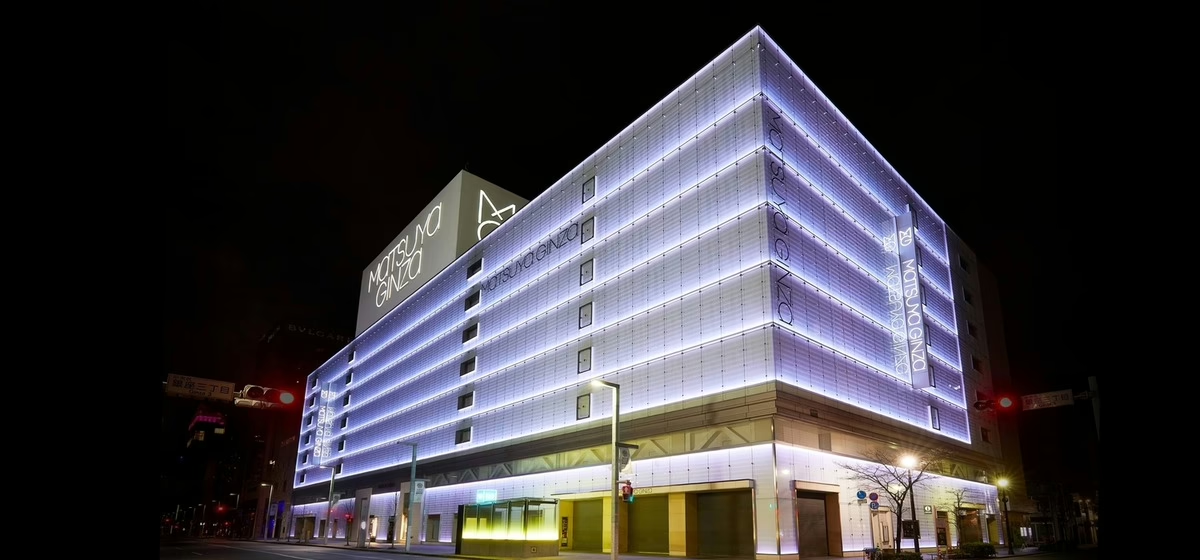
Ginza’s legendary department stores—Mitsukoshi, Matsuya, and Wako—transform luxury shopping into an art form where white-gloved elevator operators bow at precise angles and sales staff treat every purchase like a ceremonial tea service.
These palatial retail temples don’t just sell designer goods; they offer tax-free shopping that can save international visitors 10% on luxury items.
In addition, they provide personal shopping services where dedicated staff members become your fashion-savvy guides through floors of couture, cosmetics, and cutting-edge Japanese brands.
The moment you step inside, you’ll understand why these stores have survived since the Meiji era—the impeccable service alone is worth the visit, even if you’re just browsing!
Traditional Japanese Service Meets High Fashion
While Tokyo bursts with trendy boutiques and cutting-edge concept stores, Ginza’s legendary department stores represent something far more refined—a shopping experience where white-gloved elevator attendants bow at perfect 15-degree angles and staff wrap purchases with origami-level precision.
- Complimentary tea ceremonies in rooftop gardens offer tranquil escapes between shopping floors
- Kimono rentals transform visitors into elegant participants of timeless Japanese tradition
- Personal shoppers curate exclusive collections unavailable elsewhere
Tax-Free Counters and Personal Shopping Services
How does one navigate the intricate world of tax-free shopping in these palatial department stores?
Enter the shopping concierge—your passport to luxury discounts!
These multilingual specialists handle paperwork, coordinate purchases across floors, and release exclusive VIP lounges.
Present your passport, enjoy eight-to-ten percent savings on qualifying purchases, and let dedicated staff transform overwhelming options into curated experiences tailored precisely to your style preferences.
International Luxury Flagships Everywhere You Look
Ginza’s streets glitter with the architectural statements of fashion’s biggest names, where Chanel’s crystalline tower, Hermès’ glass-brick lantern, and Louis Vuitton’s monogrammed flagship compete to catch your eye at every corner.
Even if your wallet isn’t ready for a ¥500,000 handbag, pressing your nose against these windows offers a free masterclass in display artistry—each storefront styled like a gallery installation that rotates with the seasons.
These mega-stores transform luxury shopping into a visual feast, turning a simple stroll through Ginza into an open-air museum of the world’s most coveted brands.
Chanel, Hermès, and Louis Vuitton Mega-Stores
Where else in the world can shoppers encounter towering, multi-story temples dedicated entirely to single luxury brands, each one architecturally stunning and stocked with collections so extensive they’d make the flagship stores in Paris look modest?
- Chanel’s crystalline cube showcases exclusive luxury collaborations unavailable elsewhere
- Hermès’ glass lantern glows with artisan craftsmanship across ten floors
- Louis Vuitton’s mega store architecture creates an immersive brand universe
Window Shopping That Feels Like Museum Browsing
Even without spending a single yen, visitors to Ginza can enjoy what amounts to a free luxury fashion exhibition simply by strolling along Chuo-dori, the neighborhood’s glittering main boulevard.
The meticulously styled window displays showcase luxury accessories like gleaming watches and silk scarves with museum-worthy precision.
You’ll discover vintage shopping treasures nestled between flagship stores, where classic pieces shine alongside contemporary collections, creating an intoxicating blend of old-world elegance and cutting-edge design!
Ginza Six: Modern Mall Redefining the District
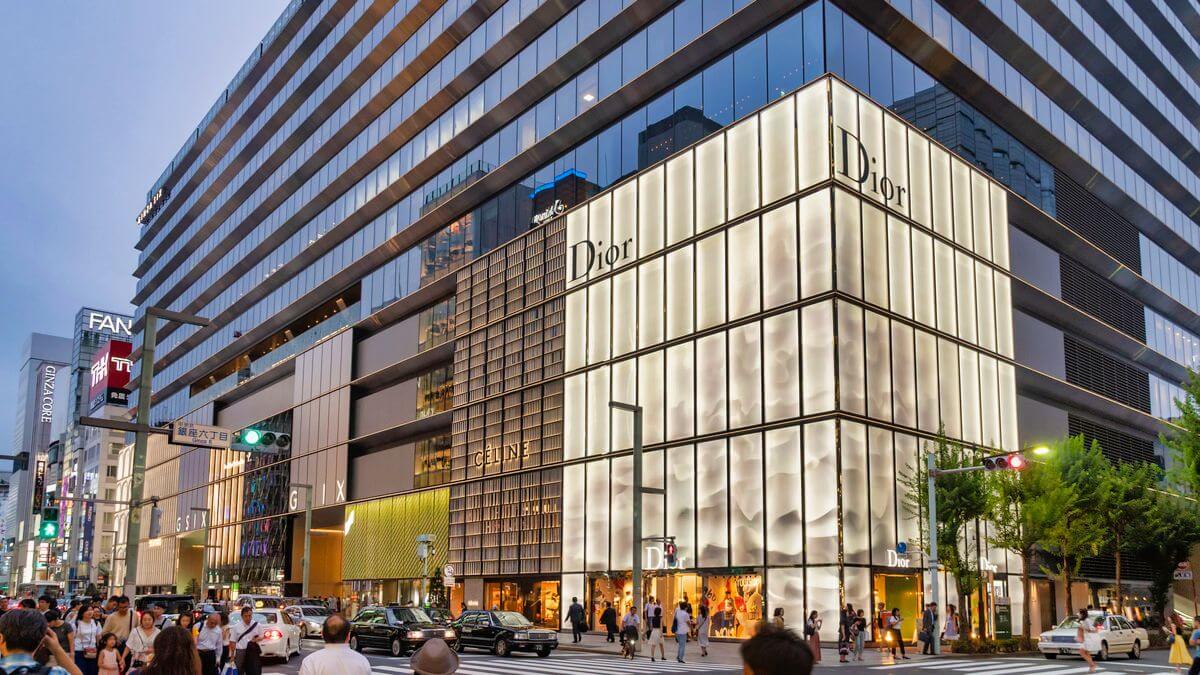
While international luxury brands occupy much of Ginza Six’s gleaming retail space, the mall has carved out impressive territory for Japan’s most exciting contemporary designers—names like Comme des Garçons, Yohji Yamamoto, and Sacai that blend traditional Japanese aesthetics with cutting-edge experimentation.
These aren’t your typical department store corners either; each brand commands dedicated boutiques with stunning architectural details, dramatic lighting, and enough breathing room to appreciate the artistry behind every asymmetrical seam and deconstructed silhouette.
Shopping here feels less like browsing and more like touring a modern art museum where you can actually take the masterpieces home!
Contemporary Japanese Designers Shine Here
Since opening in 2017, Ginza Six has become the crown jewel of the district’s shopping scene, a sprawling 13-story complex where Japan’s most celebrated contemporary designers showcase their vision alongside international luxury brands.
Issey Miyake’s experimental pleated collections transform the shopping experience into an architectural journey.
Exclusive designer collaborations drop monthly, featuring limited kawaii accessories you won’t find anywhere else.
Comme des Garçons pushes boundaries with avant-garde pieces that challenge conventional fashion.
Street Style Meccas in Harajuku
Harajuku pulses with an electric energy that transforms shopping into performance art, where teenagers in technicolor outfits browse multi-story complexes packed with cutting-edge streetwear brands you won’t find anywhere else.
The neighborhood’s fashion philosophy centers on fearless self-expression—whether you’re hunting for kawaii accessories at Laforet’s maze-like floors, scoring affordable trend pieces at fast-fashion havens like WEGO, or digging through racks of authentic American vintage at Chicago Thrift Store.
This is where Tokyo’s youth culture writes the rules, one bold outfit at a time!
Laforet Harajuku: Multi-Floor Youth Fashion Complex
Laforet Harajuku operates like a constantly evolving fashion laboratory, with boutiques rotating in and out every few months so that even veteran shoppers discover something completely new each time they walk through those iconic glass doors.
The real thrill here isn’t finding big-name brands—it’s stumbling upon cutting-edge Japanese labels like PAMEO POSE, KAWI JAMELE, or Bubbles that your friends back home have definitely never heard of.
This six-floor complex transforms shopping into a treasure hunt where yesterday’s discoveries might be gone next month, replaced by an even cooler boutique featuring some designer who’s about to blow up on Instagram.
Rotating Boutiques Keep It Fresh Every Visit
What keeps shoppers coming back to Laforet Harajuku month after month isn’t just the building’s iconic presence on Meiji-dori—it’s the constantly evolving lineup of boutiques that transforms the shopping experience with each visit.
- Seasonal pop ups introduce emerging designers testing fresh concepts before committing to permanent spaces.
- Boutique rotations ensure stale inventory never becomes an issue, with stores frequently relocating between floors.
- Limited-run collaborations create urgency, rewarding frequent visitors who discover exclusive drops.
Japanese Brands You’ve Never Heard Of Yet
This rotating boutique model creates the perfect incubator for under-the-radar Japanese labels that haven’t hit international radar yet—and probably won’t for another year or two.
You’ll stumble upon local brand gems creating avant-garde streetwear, minimalist basics with unexpected cuts, and accessories that blend traditional Japanese craftsmanship with rebellious youth energy.
These undiscovered labels represent tomorrow’s fashion today—minus the markup.
WEGO and Spinns: Fast Fashion Japanese Style
How do Tokyo’s trendiest teens stay effortlessly stylish without breaking the bank?
WEGO and Spinns dominate Harajuku’s fast fashion scene, offering constantly rotating collections that blend Korean streetwear influences with distinctly Japanese aesthetics.
These stores champion affordable experimentation, letting you build a capsule wardrobe without the guilt of overspending.
What makes these chains irresistible:
- Mix-and-match paradise: Layer oversized hoodies with pleated skirts, vintage thrift finds with platform sneakers
- Wallet-friendly pricing: Most pieces hover between ¥1,000-3,000, perfect for frequent style refreshes
- Trend-forward selections: Spot next season’s looks before they hit international markets
Both retailers sprawl across multiple Takeshita Street locations, their neon-bright storefronts practically begging you inside.
You’ll find styles ranging from kawaii pastels to edgy punk-rock pieces, all crammed into energetic spaces where Japanese teens hunt their next outfit obsession.
Chicago Thrift Store: American Vintage Done Tokyo Way
Chicago Thrift Store has mastered the art of curating American vintage pieces that feel authentically retro yet perfectly suited for Tokyo’s street fashion scene.
The best part?
This beloved vintage destination operates three separate locations all clustered within Harajuku’s walkable zone, making it ridiculously easy to hop between shops and compare their ever-rotating inventory.
Each storefront maintains its own distinct vibe while sharing that signature Chicago aesthetic—think carefully selected band tees, well-worn Levi’s, and those elusive vintage college sweatshirts that American exchange students always get jealous about.
Three Locations Within Walking Distance
Tucked away on a quiet side street just moments from Harajuku Station, Chicago Thrift Store transforms the American vintage experience through an unmistakably Tokyo lens.
Cultural influences merge beautifully here, creating seasonal shopping adventures you won’t find anywhere else.
What makes it unmissable:
- Meticulously curated denim spanning decades of American workwear
- Vintage band tees and varsity jackets displayed like gallery pieces
- Staff who genuinely geek out over provenance and styling possibilities
Designer Shopping in Ginza’s Golden Blocks
Ginza transforms Tokyo’s luxury shopping scene into something unexpectedly accessible, where flagship experiences and avant-garde concepts share the same gleaming streets.
Between Ginza Core’s affordable yet stylish finds, Dover Street Market’s mind-bending Comme des Garçons installations, and Uniqlo’s architectural flagship that elevates basics into an art form, these golden blocks prove that “designer shopping” doesn’t have to mean emptying your wallet.
Whether you’re hunting for experimental fashion statements or just want to experience retail theater at its finest, Ginza’s multilevel approach to fashion offers something brilliant for every budget and aesthetic.
Ginza Core and Marronnier Gate: Mid-Range Options
Looking for designer fashion without the heart-stopping price tags of Ginza’s luxury flagships?
Ginza Core and Marronnier Gate deliver that sweet spot between Harajuku accessories-level affordability and haute couture.
These mid-range havens blend contemporary Japanese brands with international favorites, all wrapped in Ginza architecture that whispers sophistication without screaming exclusivity.
What makes these shopping centers irresistible:
- Multi-floor treasure hunts featuring Beams, United Arrows, and emerging Japanese designers at prices that won’t demolish your travel budget
- Restaurant floors serving everything from tonkatsu to Italian fusion, perfect for refueling between fashion discoveries
- Cosmetics sections stocked with cult-favorite Asian beauty brands you can’t find back home
Both buildings attract stylish Tokyoites who appreciate quality without pretension.
You’ll score pieces that’ll turn heads stateside while keeping enough yen for tomorrow’s adventures.
Dover Street Market Ginza: Comme des Garçons Concept Store
Dover Street Market Ginza stands as Rei Kawakubo’s radical seven-story tribute to fashion as art.
Where concrete pillars, industrial fixtures, and deliberately chaotic displays create an atmosphere that feels more like a contemporary gallery than a traditional boutique.
Each floor presents a curated explosion of Comme des Garçons collections alongside carefully selected international designers, vintage finds, and emerging brands that align with Kawakubo’s uncompromising aesthetic vision.
The sheer vertical scale means shoppers ascend through distinct worlds of avant-garde clothing, accessories, and collaborative pieces that challenge conventional notions of wearability and beauty.
Seven Floors of Avant-Garde Fashion Madness
Where else can fashion lovers encounter Rei Kawakubo’s radical vision sprawling across seven gravity-defying floors of pure creative chaos?
This isn’t your typical department store—it’s where high fashion collides with street art energy and vintage markets’ rebellious spirit.
- Industrial installations transform each floor into a theatrical runway experience
- Emerging designers share space with established avant-garde labels
- Rotating pop-ups keep the merchandise unpredictable and thrilling
Uniqlo Ginza: Flagship Experience Beyond Basic Basics

The towering Uniqlo Ginza flagship transforms what many consider “basic clothing” into an art form spread across twelve gleaming floors of fashion possibility.
Each level offers something different—from the sprawling UT graphic tee collection that showcases collaborations with artists, anime franchises, and cultural icons, to cutting-edge fabric innovations that make even simple items feel special.
This isn’t your suburban mall Uniqlo; it’s a carefully curated experience where Japanese retail excellence meets accessible style.
And yes, you’ll probably leave with way more T-shirts than you planned!
Twelve Floors Including UT Graphic Tees Galore
Spanning an impressive twelve stories in the heart of Ginza, Uniqlo’s flagship transforms the brand’s reputation from basic wardrobe staples into a full-fledged fashion destination worthy of its glittering address.
The entire fourth floor showcases UT graphic tees featuring collaborations with artists, anime characters embodying kawaii aesthetics, and streetwear brands.
Dedicated floors display seasonal collections with sophisticated fabric technology.
Customization stations let you personalize purchases on-site.
Japanese Fashion Brands Worth Knowing
Tokyo’s fashion scene runs on homegrown talent, and knowing which Japanese brands to hunt down will seriously level up your shopping game.
The streetwear powerhouses of Harajuku—think Bape’s ape head logo, Undercover’s rebellious edge, and Neighborhood’s motorcycle-inspired cool—contrast beautifully with Ginza’s avant-garde trinity of Comme des Garçons, Yohji Yamamoto, and Issey Miyake, designers who’ve been reshaping silhouettes since the 1980s.
For those seeking quality without the designer price shock, the holy trinity of accessible multi-brand retailers—Beams, United Arrows, and Ships—curate the best of Japanese and international fashion under one roof.
Harajuku Heroes: Bape, Undercover, and Neighborhood
Long before Supreme drops caused worldwide hysteria and Yeezy slides became airport staples, Harajuku’s underground shops were quietly engineering the streetwear revolution that would reshape global fashion.
Brands like Bape, Undercover, and Neighborhood didn’t just create clothes—they invented an entirely new visual language.
This language mixed Japanese craftsmanship with hip-hop swagger, military references, and punk rebellion that luxury houses are still copying today.
What started as niche labels sold in cramped Ura-Harajuku boutiques now commands astronomical resale prices and celebrity endorsements worldwide.
Yet their Tokyo flagships remain the holy grail for anyone serious about streetwear.
Streetwear That Started Here, Conquered Everywhere
What happens when rebellious Japanese designers decide to flip Western streetwear on its head and serve it back with Tokyo’s unmistakable edge?
You get global domination, that’s what!
- Supreme’s legendary streetwear collaborations with Japanese brands sparked worldwide hype drops
- Sustainable fabrics now merge with avant-garde designs, proving eco-consciousness looks damn good
- Limited-edition releases create frenzied collectors hunting Tokyo’s hidden boutiques for authenticated grails
Ginza Favorites: Comme des Garçons, Yohji Yamamoto, Issey Miyake
While Harajuku celebrates streetwear rebellion, Ginza’s elegant boulevards showcase the avant-garde titans who fundamentally transformed how the entire world thinks about fashion.
Comme des Garçons, Yohji Yamamoto, and Issey Miyake didn’t just create clothing—they shattered Western conventions of silhouette, color, and construction when they stormed Paris runways in the 1980s with their radical “anti-fashion” philosophies.
These designers pioneered deconstructed seams, asymmetrical cuts, and predominantly black palettes that initially shocked critics but ultimately redefined modern design, earning them permanent places in museums and fashion history books worldwide.
Japanese Designers Who Changed Global Fashion
Three revolutionary Japanese designers shattered Western fashion conventions in the 1980s and permanently altered the global runway landscape—Rei Kawakubo of Comme des Garçons, Yohji Yamamoto, and Issey Miyake.
Their avant-garde approach sparked today’s streetwear evolution and designer collaborations:
- Deconstruction techniques replacing traditional tailoring
- Monochromatic palettes challenging color-obsessed Western runways
- Asymmetrical silhouettes rejecting body-conforming shapes
These visionaries transformed fashion into wearable art you’ll discover throughout Ginza’s flagship stores!
Accessible Japanese Brands: Beams, United Arrows, Ships
Here’s the thing about Beams, United Arrows, and Ships that makes them so brilliant for fashion hunting—each location operates like its own carefully curated universe, tailored to match the vibe and clientele of its neighborhood.
The Shibuya outpost of Beams might stock edgier streetwear and collaboration pieces aimed at the area’s young crowd, while the same brand’s Ginza branch leans toward refined, office-friendly selections that wouldn’t look out of place at a business casual event.
This strategic neighborhood customization means you can’t just hit one store and call it done; savvy shoppers treat each district’s version as a completely different experience!
Where These Multi-Location Chains Differ by District
Each Beams, United Arrows, and Ships location cultivates its own distinct personality based on the neighborhood it calls home.
- Ginza stores lean heavily into luxury collaborations, offering refined pieces that match the district’s polished sophistication.
- Harajuku outposts embrace vintage authenticity, stocking edgier selections that speak to the area’s creative rebellion.
- Shibuya branches strike a youthful balance, mixing accessible everyday wear with statement pieces.
Vintage and Secondhand Shopping Comparison in Tokyo
Tokyo’s vintage and secondhand scene splits into two distinct personalities that cater to completely different shopping vibes.
Harajuku serves up treasure-hunt energy with its warren of eclectic shops—Kinji, Santa Monica, and Flamingo overflow with racks where you’ll hunt through denim, band tees, and quirky statement pieces at student-friendly prices.
Meanwhile, Ginza takes the luxury consignment route with polished boutiques like Ragtag and Brand Collect, where pre-loved designer items sit under spotlights like museum pieces, offering substantial savings on pieces that still carry their original prestige.
Harajuku’s Vintage Paradise: Kinji, Santa Monica, Flamingo
The real magic of Harajuku’s vintage scene lies in how Japanese buyers meticulously source American vintage pieces—think perfectly worn Levi’s 501s, champion reverse weave sweatshirts, and faded band tees—then curate them with an eye for quality and authenticity that honestly puts most American thrift stores to shame.
What you’re getting isn’t just random secondhand clothing; it’s a carefully selected collection where someone has already done the hunting for you, filtering out the junk and keeping only the pieces with the right fit, fade, and story.
This Japanese interpretation of American casual wear has become so refined that fashion enthusiasts actually fly from the US to Tokyo to buy back their own country’s vintage, which tells you everything you need to know about the curation standards here!
American Vintage Curated Through Japanese Eyes
Why does vintage shopping in Tokyo feel like discovering America’s closet through a completely different lens?
Japanese curators possess an uncanny ability to elevate secondhand American pieces into coveted treasures, creating vintage fusion that transforms faded Levi’s and collegiate sweaters into premium finds through meticulous selection and styling expertise.
The Japanese perspective reshapes American vintage through:
- Rigorous quality control rejecting anything with imperfections
- Museum-worthy presentation treating garments like artifacts
- Price points reflecting cultural reverence for preservation
Ginza’s Upscale Consignment: Ragtag and Brand Collect
Ginza’s luxury consignment scene brings designer dreams within reach, where shops like Ragtag and Brand Collect stock pristine Chanel bags, Hermès scarves, and Comme des Garçons pieces at 30-70% off retail prices.
These aren’t sketchy basement operations—both stores employ trained experts who meticulously authenticate every item through serial number verification, material analysis, and construction inspection before anything hits the sales floor.
You’ll find condition grades clearly labeled on each piece, plus detailed provenance information that gives you complete confidence you’re walking away with the real deal, not some convincing fake from a back-alley workshop.
Designer Pieces at Fraction of Original Prices
For savvy shoppers who know their Chanel from their Céline, Ginza’s upscale consignment scene offers a treasure trove of authenticated luxury goods at prices that won’t require selling a kidney.
This is vintage thrifting elevated to an art form, where budget tips meet high fashion.
- Pristine Hermès bags at 40-60% off retail
- Authenticated designer pieces with certificates of authenticity
- Seasonal sales slashing prices even further on coveted brands
Authentication Process: Why You Can Trust These Shops
The authentication process at Tokyo’s premium consignment stores operates with the precision of a Swiss watchmaker and the scrutiny of a museum curator, making knockoff anxiety a thing of the past.
Expert authenticators examine every stitch, logo, and serial number through luxury authentication protocols that would make detectives jealous.
Both Ragtag and Brand Collect employ trained specialists who’ve mastered vintage verification techniques, ensuring your Chanel bag or Hermès scarf is genuinely spectacular, not spectacularly fake!
Budget Shopping Strategies by District in Tokyo
Tokyo’s fashion districts each demand wildly different budget strategies, and mastering them transforms shopping from a wallet-draining panic into a genuine skill.
Whether you’re assembling a complete Harajuku look for under ¥10,000, turning Ginza’s luxury storefronts into your personal runway show, or maneuvering the surprisingly complex world of tax-free purchases, each neighborhood plays by its own financial rules.
Smart shoppers who understand these district-specific tactics can score incredible finds while tourists nearby hemorrhage yen on tourist-trap mediocrity.
Harajuku on ¥10,000: Full Outfit Achievable
The real magic happens when savvy shoppers blend vintage treasures from Harajuku’s legendary secondhand stores with strategic new pieces—think a ¥3,000 retro band tee from Chicago paired with fresh ¥2,500 wide-leg pants from WEGO.
This mix-and-match approach not only stretches that ¥10,000 budget further but creates genuinely unique looks that scream “I know Tokyo fashion” rather than “I raided a single fast-fashion rack.”
Smart shoppers hit the thrift stores first to score statement pieces with character, then fill gaps with affordable basics that make those vintage gems shine!
Mixing Thrift With New for Maximum Style
Savvy shoppers discover that Harajuku’s greatest style secrets emerge when vintage treasures meet contemporary basics in unexpected combinations.
Mastering thrift shop etiquette opens doors to unique finds that transform simple UNIQLO tees into statement outfits.
Winning combinations include:
- Vintage sneakers from Kinji paired with fresh streetwear
- Retro jackets layered over minimalist basics
- Heritage accessories elevating affordable contemporary pieces
This strategic mixing maximizes both budget and individual expression!
Ginza Window Shopping: Free and Actually Fun
Ginza’s gleaming flagships might seem purely aspirational, but savvy shoppers know the real treasure hunt happens during sample sales and special discount periods.
Department store basement floors (depachika) post seasonal clearance announcements near elevators.
Meanwhile, luxury boutiques hold invitation-only sample sales that often welcome walk-ins during final hours—usually advertised through small sidewalk sandwich boards in January and July.
The key is timing your window shopping expeditions to coincide with these events, transforming Ginza from an intimidating display of wealth into an actual shopping destination where last season’s Comme des Garçons blazer suddenly becomes attainable.
Sample Sales and Department Store Discounts
For all its glittering reputation, Ginza actually offers serious bargains if you know when to shop—and those magic moments happen more often than you’d think!
- Major department stores like Mitsukoshi and Matsuya host legendary sample sales each season, slashing designer prices by 50-70%.
- January and July bring building-wide clearance events with luxury souvenirs at accessible prices.
- Floor staff discreetly share upcoming sale dates with regular visitors.
Tax-Free Shopping: Who Wins This Round
Tax-free shopping in Tokyo transforms every purchase into an instant 10% discount—a game-changer when hunting for bargains across different districts.
Ginza absolutely dominates this category, housing prestigious department stores like Mitsukoshi and Matsuya that streamline the tax refund process with dedicated counters and English-speaking staff.
You’ll breeze through paperwork while clutching your luxury souvenirs, passport in hand.
Harajuku’s smaller boutiques often lack the infrastructure for smooth tax-free transactions—many independent shops don’t participate at all, forcing shoppers to choose between quirky finds and fiscal responsibility.
The winner?
Ginza claims victory for budget-conscious travelers who understand that saving 10% on high-ticket items means more money for street food, vintage treasures, or that impulsive karaoke session you’ll definitely want later.
Sneaker and Streetwear Culture in Tokyo
Tokyo’s sneaker and streetwear scene pulses with an energy that transforms shoe shopping into a full-blown cultural experience.
Limited drops cause lines around the block, and vintage finds command serious respect.
Harajuku stands as ground zero for this obsession, with legendary shops like Atmos and Mortar stocking everything from grail-worthy Air Jordans to obscure Japanese collaborations you won’t find anywhere else.
The real magic happens when you navigate these districts with intention, knowing that each neighborhood—from Shibuya’s hype beast havens to Omotesando’s more refined streetwear boutiques—offers its own distinct flavor of the sneaker game.
Harajuku’s Sneaker Shops: Atmos and Mortar
Release day at Atmos or Mortar transforms these shops into buzzing epicenters of sneaker obsession, where devoted collectors line up hours before opening to snag coveted collaborations and limited-edition drops that might sell out within minutes.
The Japanese sneaker market operates on a different level of intensity—raffles, online reservations, and the occasional first-come-first-served chaos create an addictive hunt that turns casual shoppers into strategic planners checking Instagram drops and release calendars religiously.
Understanding this culture means accepting that scoring those exclusive Nike SB Dunks or rare Yeezy colorways requires equal parts timing, persistence, and sheer determination, but the thrill of walking away with that special box makes every early morning worth it!
Release Day Culture and Limited Edition Hunting
Why do sneakerheads wake up before dawn, line up in the cold, and refresh online stores with obsessive precision?
Tokyo’s release day culture transforms limited edition releases into adrenaline-fueled missions.
Harajuku’s streetwear collaborations drop without warning, creating legendary campouts where dedication meets opportunity.
The Hunt Includes:
- Pre-dawn queues snaking around Atmos during hyped Nike collabs
- Raffle systems determining who scores coveted Supreme drops
- Resale culture where patience potentially yields profit
Ginza’s Sports Luxury: Nike Harajuku Wait, Wrong District
Despite the playful title confusion, Ginza’s actual sneaker crown jewels are the massive Adidas flagship store—a sleek, multi-story temple to the three stripes—and Dover Street Market’s carefully curated sneaker section, where limited releases and avant-garde collaborations sit alongside high fashion pieces.
The Adidas flagship spans several floors of pure athletic luxury, showcasing everything from retro Superstars to cutting-edge Yeezy drops and Japan-exclusive colorways you won’t find back home.
Meanwhile, Dover Street Market takes a more artistic approach, treating sneakers as wearable sculpture within their famously experimental retail space where Comme des Garçons meets the hottest streetwear collaborations.
Actually Adidas Flagship and Dover Street Market Sneakers
The sneaker scene in Ginza operates on a completely different frequency than Harajuku’s hype-beast energy—here, it’s all about polished luxury meets athletic heritage.
Shoppers arrive in tailored suits rather than Supreme hoodies, and marble floors replace scuffed concrete.
The adidas flagship store showcases limited collaborations alongside performance lines in a sleek, minimalist setting.
Dover Street Market sneakers occupy curated corners, featuring exclusive drops you won’t find anywhere else.
Premium leather finishes and understated colorways dominate over loud, attention-grabbing designs.
Kimono and Traditional Fashion Options in Tokyo
Tokyo’s kimono scene splits beautifully between two distinct shopping philosophies, each offering its own path to finding that perfect traditional garment.
Over in Harajuku, you’ll discover Chicago’s playful reimagining of vintage kimono alongside quirky secondhand stores where pre-loved pieces wait for their next adventure—perfect if you’re after something unique without the formal commitment.
Meanwhile, Ginza brings the heavyweight prestige with Tanaka’s meticulous craftsmanship and Mitsukoshi’s department store elegance, where sales staff treat every kimono fitting like the important occasion it truly is!
Harajuku’s Modern Kimono: Chicago and Vintage Stores
Harajuku’s vintage stores have transformed the kimono from formal heirloom into everyday street style, and the results are absolutely spectacular!
Shoppers can find everything from lightweight cotton yukata paired with combat boots to ornate obi belts repurposed as statement accessories over graphic tees.
The neighborhood’s Chicago (secondhand store) culture encourages mixing centuries-old silk pieces with modern denim, creating looks that honor tradition while screaming contemporary cool.
Wearing Traditional Garments Contemporary Ways
Blending centuries-old craftsmanship with street-style edge, Tokyo’s contemporary kimono scene transforms traditional silk garments into everyday fashion statements that turn heads from Shibuya to Shinjuku.
Modern Kimono Styling Elements:
- Kimono modernization through denim jackets layered over vintage yukata creates unexpected texture combinations
- Contemporary obi styling replaces rigid traditional ties with slouchy knots and asymmetrical draping
- Sneakers and combat boots ground flowing silk sleeves in urban rebellion
Ginza’s Established Kimono Retailers: Tanaka and Mitsukoshi
For those eyeing truly exquisite kimono that’ll last a lifetime—think weddings, tea ceremonies, and those once-in-a-decade formal events—Ginza’s prestigious department stores and specialized retailers deliver unmatched quality and craftsmanship.
The classic Mitsukoshi flagship houses multiple kimono boutiques across its floors, while venerable shops like Tanaka (founded in 1892!) offer everything from silk furisode adorned with hand-painted cranes to understated iromuji in subtle seasonal hues.
Before committing to a purchase that might cost anywhere from ¥100,000 to well over ¥1,000,000, smart shoppers should seriously consider Ginza’s excellent rental services, which provide the same stunning garments for special occasions at a fraction of the investment price.
Investment Pieces and Formal Occasions
Ginza’s glittering streets transform into a corridor of cultural heritage when shoppers seek authentic kimono from the district’s legendary retailers.
These establishments specialize in formal investment pieces that’ll last generations, pairing exquisite silk garments with luxury accessories like hand-embroidered obi belts and custom-fitted geta sandals.
- Tanaka’s master artisans provide personalized consultations for weddings and tea ceremonies.
- Mitsukoshi’s department showcases seasonal collections alongside traditional craftsmanship techniques.
- Private fitting rooms guarantee perfect draping for life’s most significant celebrations.
Rental vs. Purchase: When Each Makes Sense
When visitors contemplate kimono acquisition at Tanaka or Mitsukoshi, the rental-versus-purchase decision hinges on frequency of use and budget realities.
Rental works brilliantly for one-time tea ceremonies or festival experiences, typically costing ¥5,000-15,000.
Purchase makes sense for repeat wearers, though vintage shopping at Ginza’s secondhand boutiques offers budget friendly tips—authentic pre-owned kimono start around ¥30,000, delivering authentic craftsmanship without the premium price tag!
Beauty and Cosmetics Shopping Comparison in Tokyo
Tokyo’s beauty scene splits dramatically between Harajuku‘s playful experimentation and Ginza’s refined elegance, offering makeup lovers two totally different shopping personalities within the same city.
In Harajuku, mega-stores like Loft and Plaza overflow with quirky Korean sheet masks, pastel eyeshadows shaped like macarons, and those weird but wonderful peel-off lip tints that stain your mouth candy-apple red.
Meanwhile, Ginza’s gleaming Shiseido flagship and venerable department store beauty halls present hushed, white-gloved luxury where serious skincare devotees drop serious yen on anti-aging serums packaged like precious jewels.
Harajuku’s Quirky Cosmetics: Loft and Plaza
Both Loft and Plaza have become ground zero for the beautiful collision of Korean and Japanese beauty trends, where glass skin serums from Seoul share shelf space with cult-favorite Japanese essences!
You’ll find Korean cushion compacts reimagined with Japanese SPF technology, sheet mask varieties that blend K-beauty’s innovative ingredients with J-beauty’s gentle formulations, and hybrid makeup lines that marry Korea’s bold color palettes with Japan’s precision applicators.
The best part is watching how these two beauty powerhouses inspire each other—what starts as a trending ingredient in Myeongdong often appears in a refined, elegantly packaged version in Harajuku just months later.
K-Beauty and J-Beauty Crossover Products
The beauty aisles at Harajuku’s Loft and Plaza have become ground zero for an exciting cultural mashup, where Korean skincare innovations meet Japanese cosmetic artistry in products that blend the best of both worlds.
- Hybrid sheet masks featuring K-beauty’s essence-soaked technology wrapped in Japan’s sustainable packaging designs
- Cushion foundations combining Seoul’s glow-boosting formulas with Tokyo’s natural finish preferences
- Fermented skincare merging Korean ingredients with Japanese minimalist bottle aesthetics
Ginza’s Luxury Beauty: Shiseido Flagship and Department Stores
Ginza transforms beauty shopping into an elegant ritual where centuries-old Japanese skincare wisdom meets cutting-edge cosmetic science, particularly at the stunning Shiseido Flagship store where minimalist design showcases the brand’s heritage.
Unlike Harajuku’s playful cosmetics hunting grounds, Ginza’s department stores—Mitsukoshi, Matsuya, Matsuzakaya—offer white-glove service through beauty advisors who spend genuine time analyzing your skin, discussing your concerns, and meticulously applying products so you can experience textures and results before committing.
This personalized approach means you’re not just buying lipstick; you’re receiving a tailored consultation that considers everything from Tokyo’s humidity to your specific skin goals, all delivered with the gracious hospitality that makes Japanese customer service legendary.
Traditional Japanese Beauty Philosophy Meets Innovation
When stepping into Ginza’s beauty retail landscape, shoppers encounter a fascinating collision of centuries-old Japanese skincare wisdom and cutting-edge cosmetic technology that’s impossible to find anywhere else in the world.
- Shiseido’s flagship store showcases contemporary minimalism through sleek architectural design while honoring traditional craftsmanship in ingredient sourcing.
- Department store beauty counters offer personalized consultations blending ancestral facial massage techniques with AI skin analysis.
- Exclusive formulations feature time-tested ingredients like rice bran and camellia oil enhanced by molecular science.
Personalized Consultations and Product Testing
What truly sets Ginza’s beauty shopping apart from anywhere else in Tokyo—or frankly, the world—is the extraordinary level of personalized attention shoppers receive during consultations.
Expert beauty advisors spend genuine time understanding your skin, lifestyle, and aesthetic goals before recommending anything.
The personalized styling sessions include detailed product testing—you’ll actually try foundations, serums, and treatments to discover what works uniquely for you!
Accessories and Jewelry Districts in Tokyo
Tokyo’s accessory and jewelry shopping scene splits dramatically between neighborhoods, offering everything from pocket-friendly trinkets to investment-worthy heirlooms that’ll make your heart race.
Harajuku transforms accessory hunting into an adventure playground, where you can snag kawaii hair clips at Claire’s for pocket change, then wander into indie designer boutiques selling handcrafted statement pieces that nobody back home will own.
Meanwhile, Ginza gleams with the sophisticated allure of fine jewelry, hosting Mikimoto’s legendary pearl showrooms alongside the iconic blue boxes of Tiffany & Co., where each display case holds treasures that deserve their own security detail.
Harajuku’s Affordable Accessories: Claire’s to Independent Designers
Harajuku’s accessory scene proves you don’t need a trust fund to look like you raided a stylist’s personal collection—statement pieces under ¥5,000 are literally everywhere you turn.
From chunky chain necklaces that could anchor a yacht to geometric acrylic earrings in eye-popping colorways, independent designers and chain stores alike have cracked the code on affordable drama.
The best part?
These pieces photograph like they cost ten times their actual price, making your Instagram followers wonder if you suddenly won the lottery.
Statement Pieces Under ¥5,000 Everywhere
How does one transform an entire outfit without breaking the bank?
Harajuku delivers spectacular statement pieces that won’t devastate your wallet!
Vintage markets overflow with sustainable fabrics crafted into bold accessories, while independent designers create conversation-starting jewelry that screams individuality.
- Chunky resin rings and oversized earrings at Takeshita Street’s boutiques
- Hand-painted scarves featuring anime-inspired designs from local artisans
- Upcycled denim bags with embroidered patches celebrating personal expression
Ginza’s Fine Jewelry: Mikimoto Pearls and Tiffany
Ginza transforms into a glittering showcase of jewelry artistry where every storefront—from the legendary Mikimoto flagship with its pearl-draped windows to Tiffany’s iconic blue boxes gleaming under spotlights—becomes an Instagram-worthy masterpiece that attracts crowds even among those with zero intention to buy.
The real skill lies in knowing when to invest in a timeless Mikimoto pearl necklace that’ll outlast trends for generations versus when to admire the craftsmanship, snap those photos, and save your yen for more practical purchases in Harajuku.
These aren’t just stores; they’re free museums of design where browsing costs nothing but teaches you everything about quality, helping you make smarter jewelry decisions whether you’re spending ¥500 or ¥500,000.
Window Displays Worth Photographing
Luxury jewelry houses transform their storefronts into illuminated galleries that rival any museum exhibit, and nowhere is this artistry more stunning than along Ginza’s glittering main boulevard.
- Mikimoto’s windows showcase cascading pearl installations that change seasonally, creating backdrop magic for fashion photography enthusiasts.
- Tiffany’s iconic blue-box displays glow like precious street art against Tokyo’s neon nights.
- Cartier’s architectural presentations feature rotating sculptures worthy of their own Instagram accounts.
When to Splurge vs. When to Save
Beyond admiring these spectacular window displays, smart shoppers need a game plan for distinguishing genuine investment pieces from purchases better made elsewhere.
Ginza’s legendary Mikimoto pearls represent true luxury bargains—heirloom quality at surprisingly reasonable prices compared to Western boutiques.
However, budget splurging on Tiffany silver accessories makes little sense here, since those same items cost identically worldwide without the added currency conversion hassle!
Menswear Shopping in Harajuku and Ginza
Tokyo’s menswear scene splits dramatically between these two iconic districts, offering completely different vibes for guys looking to upgrade their wardrobes.
Harajuku champions experimental, gender-fluid styles where oversized silhouettes, streetwear collabs, and avant-garde pieces blur traditional masculinity.
You’ll find everything from deconstructed basics at COMME des GARÇONS to wild graphic tees that would turn heads anywhere.
Meanwhile, Ginza maintains its reputation as Tokyo’s premier destination for classic menswear, housing flagship stores of legendary tailors like Isetan Men’s and international luxury brands.
Here, pristine suits, crisp dress shirts, and Italian leather shoes reign supreme.
Harajuku’s Gender-Fluid Fashion Scene
Harajuku’s menswear scene throws traditional gender boundaries out the window, championing oversized silhouettes that drape and flow rather than follow conventional masculine cuts.
Designers here revel in maximalist prints—think psychedelic florals, anime-inspired graphics, and kaleidoscopic geometric patterns that would make your dad’s tie collection look downright conservative!
The neighborhood’s boutiques stock everything from voluminous drop-shoulder hoodies to palazzo pants with wild abstract designs, creating a playground where anyone can experiment with proportion and color regardless of what society expects them to wear.
Oversized Streetwear and Bold Patterns
Why should menswear shoppers confine themselves to traditional sizing when Tokyo’s most exciting fashion hubs champion the liberating aesthetic of oversized silhouettes and eye-popping patterns?
Both districts celebrate this trend differently:
- Harajuku’s vintage shops overflow with baggy graphic tees, parachute pants, and vintage accessories that create playful, androgynous looks.
- Ginza boutiques reinterpret oversized cuts through luxury fabrics and architectural draping.
- Bold patterns—from anime prints to abstract geometrics—dominate both neighborhoods’ menswear collections.
Ginza’s Classic Menswear: Suits and Business Attire
Ginza transforms into a masterclass in sophisticated menswear, where heritage Japanese tailoring houses stand alongside international luxury brands offering impeccably cut suits that blend European tradition with Japanese precision.
The neighborhood’s legendary department stores—Mitsukoshi, Matsuya, and Ginza Six—dedicate entire floors to men’s business attire, creating sprawling showcases where salary men and executives can find everything from conservative navy pinstripes to subtly adventurous fabrics that push workplace boundaries just enough.
What makes Ginza special isn’t just the premium quality (though you’ll definitely feel that buttery Italian wool), but the white-glove service, with expert staff who understand that a perfectly fitted suit can literally change how a man moves through his professional world.
Traditional Tailoring Meets Modern Cuts
How does a city simultaneously preserve century-old sartorial traditions while embracing cutting-edge design innovation?
Tokyo’s menswear scene masterfully blends heritage craftsmanship with contemporary silhouettes, creating something remarkably fresh!
- Vintage revival techniques meet sustainable fabrics in eco-conscious collections
- Master tailors reinterpret classic patterns with slimmer, movement-friendly fits
- Traditional wool suiting incorporates performance materials for modern professionals
You’ll discover tradition evolving beautifully here.
Department Store Men’s Floors: Comprehensive Selection
Tokyo’s legendary department stores transform entire floors into all-encompassing menswear kingdoms where business professionals can outfit themselves head to toe without stepping outside.
These retail powerhouses blend fashion tech innovations like virtual fitting rooms with deep-rooted cultural influences that honor traditional business dress codes.
From impeccably tailored suits to coordinating accessories, each floor functions as your personal styling command center, offering expert consultants who navigate you through Japan’s exacting professional wardrobe standards.
Shopping Hours and Best Times to Visit Ginza and Harajuku
Timing your shopping expedition can make the difference between fighting crowds and scoring that perfect jacket in peace—and trust me, Tokyo’s fashion districts each have their own rhythm.
Hit Harajuku on a weekday morning and you’ll catch local fashionistas hunting for treasures before the tourist buses arrive, while the vintage shops and indie boutiques feel like your personal playground.
Over in Ginza, weekdays transform the polished boulevards into a serious shopper’s paradise, where you can actually browse luxury racks without bumping elbows and get the undivided attention of knowledgeable staff.
Harajuku Weekday Mornings: Local Shoppers Rule
While weekday mornings offer a serene shopping experience dominated by savvy locals hunting for the latest drops, weekend afternoons transform Harajuku into an absolute circus of selfie sticks, tour groups, and shoulder-to-shoulder crowds that can turn a simple browse into an exhausting shuffle.
Takeshita Street becomes nearly impassable between 1 PM and 5 PM on Saturdays and Sundays, when international tourists and domestic day-trippers converge in waves that pack the narrow lane to maximum capacity.
Smart shoppers know that weekend afternoons demand serious patience and strategic timing—or better yet, they simply avoid this peak chaos altogether and stick to those blissfully quiet Tuesday and Wednesday mornings instead.
Weekend Afternoon Madness: Tourist Peak Times
If there’s one time to avoid Harajuku unless crowds energize rather than drain, it’s weekend afternoons between noon and 5 PM when the district transforms into a slow-moving river of humanity.
- Takeshita Street becomes shoulder-to-shoulder packed, making browsing local street markets nearly impossible.
- Popular stores develop 30-minute queues just to enter, killing your shopping momentum.
- Fashion event tickets and limited drops sell out by 11 AM, leaving latecomers empty-handed.
Ginza’s Quieter Weekdays: Serious Shopping Time
While weekdays in Ginza bring a more relaxed, business-focused atmosphere perfect for focused browsing through luxury boutiques and department stores, the real magic happens on Sundays when the main boulevard transforms into a car-free pedestrian paradise called Hokosha Tengoku (literally “pedestrian heaven”).
Most Ginza shops close their doors by 8 PM sharp, but savvy shoppers know that certain department stores like Matsuya and Don Quijote break the mold, keeping their fashion floors illuminated and staffed well into the evening.
The contrast between weekday serenity and Sunday‘s festive street scene creates two completely different shopping experiences in the same glittering district—choose your vibe based on whether you want elbow room or electric energy!
Sunday Pedestrian Paradise: Car-Free Streets
Every Sunday from noon to 5 PM (6 PM during summer months), Ginza’s main thoroughfare transforms into a pedestrian wonderland called *Hokōsha Tengoku*, literally “Pedestrian Paradise.
The entire Chuo-dori avenue gets closed to traffic, letting shoppers stroll down the middle of streets normally packed with luxury cars, creating this surreal experience where department store facades tower above without the usual cacophony of engines and horns.
Street performers and occasional street art pop up along the boulevard.
Hidden gems emerge as you explore side alleys branching off the main drag.
Outdoor café seating spills onto the pavement.
Late Night Shopping: Who Stays Open Past 8 PM
Most Tokyo shops slam their shutters down at 8 PM sharp, but Ginza operates on a different rhythm—one that caters to the after-work crowd who’ve just escaped their desks and are ready to finally browse without rushing.
The district’s late night boutiques keep glowing until 9 or 10 PM, while strategically placed 24 hour cafes let you caffeinate between shopping sprees, making evening exploration genuinely possible here.
Food and Break Options While Shopping
Shopping in Tokyo can work up quite an appetite, and luckily the city’s fashion districts offer incredible eating options that match their retail credentials.
Harajuku delivers a parade of Instagram-worthy street food stalls and quirky themed cafes where shoppers can refuel between vintage finds and trendy boutiques.
Meanwhile, Ginza transforms the lunch break into a sophisticated affair with its collection of Michelin-starred restaurants and century-old establishments.
Whether grabbing a fluffy crepe on Takeshita Street or savoring kaiseki at a legendary Ginza institution, these dining experiences become memorable highlights of any Tokyo shopping adventure!
Harajuku’s Street Food and Trendy Cafes
Shopping through Harajuku’s fashion paradise works up quite an appetite, and luckily the neighborhood serves up some of Tokyo’s most photogenic and delicious street snacks.
Takeshita Street overflows with rainbow-colored crepe stands wrapping fresh fruit, whipped cream, and candy into handheld masterpieces.
Meanwhile, bubble tea shops compete with ever-more-outrageous flavors and toppings that practically beg to be posted on social media.
From cotton candy clouds bigger than your head to meticulously crafted parfaits towering with cookies, brownies, and ice cream, Harajuku transforms simple desserts into edible art that tastes as amazing as it looks!
Crepes, Tapioca, and Instagram-Worthy Desserts
Why settle for ordinary snacks when Harajuku’s street food scene transforms every shopping break into a photo-worthy celebration?
Takeshita Street overflows with rainbow-wrapped crepes bursting with fresh fruit and whipped cream, while dessert cafes serve elaborate parfaits that tower skyward.
- Marion Crepes offers customizable wraps stuffed with unconventional combinations.
- Gong Cha and CoCo deliver perfectly chewy boba tea in countless flavors.
- Totti Candy Factory creates cotton candy masterpieces in fantastical shapes.
Ginza’s Restaurant Scene: Michelin Stars and Historic Venues
Ginza transforms from luxury shopping paradise into a culinary wonderland the moment hunger strikes, offering everything from basement-level depachika food halls packed with immaculate bento boxes and artisan sweets to white-tablecloth Michelin-starred establishments that justify their price tags with every extraordinary bite.
The department store food halls—especially those beneath Mitsukoshi and Matsuya—function as edible museums where shoppers can graze on seasonal delicacies, sample regional specialties, and pick up perfectly packaged omiyage gifts without ever stepping outside.
When shopping fatigue finally catches up, the neighborhood’s elegant tea salons and historic kissaten (traditional coffee shops) provide cushioned respite where weary feet can recover while savoring meticulously prepared matcha or silky-smooth Japanese cheesecake.
Department Store Depachika: Gourmet Food Halls
How does one discover Tokyo’s most spectacular culinary treasures without even stepping foot in a restaurant?
Head straight to Ginza’s legendary department store depachika—those magnificent basement-level gourmet food halls where Japan’s finest culinary artisans showcase edible masterpieces!
- Towering displays of jewel-like wagashi (traditional sweets) arranged with museum-quality precision
- Pristine sushi counters offering melt-in-your-mouth toro by the piece
- Perfectly wrapped bento boxes that transform lunch into portable luxury
Taking Breaks: Where to Rest Your Shopping Legs
After hours of exploring Ginza’s glittering flagship stores and designer boutiques, even the most dedicated shoppers need to refuel—and this neighborhood delivers dining experiences as luxurious as its window displays.
Michelin-starred restaurants dot the district, offering resting spots where you can savor world-class sushi or French cuisine.
Historic kissaten (coffee houses) provide perfect leisurely breaks, serving impeccable coffee and decadent desserts in elegantly retro settings.
Personal Styling and Shopping Services
Tokyo’s fashion districts take wildly different approaches to helping shoppers navigate their style journeys, and understanding these contrasting philosophies can totally transform your shopping experience.
In Harajuku, the vibe is all about independent exploration and creative self-discovery—店員 (ten’in, shop staff) will answer questions if asked, but they generally embrace a hands-off approach that lets you dig through vintage bins, mix clashing patterns, and figure out your own aesthetic without anyone hovering over your shoulder.
Meanwhile, Ginza‘s luxury department stores and boutiques offer the complete opposite: attentive personal shoppers who’ll guide you through entire floors of designer goods, arrange private fitting rooms, and even coordinate multi-piece outfits based on your lifestyle and budget.
Harajuku’s DIY Fashion Philosophy: Figure It Out Yourself
While Harajuku’s fashion scene celebrates independent experimentation and creative self-expression, the staff at vintage shops, streetwear boutiques, and independent stores are genuinely ready to assist once you make the first move.
Unlike some luxury shopping districts where salespeople hover and offer unsolicited advice, Harajuku operates on a “we’re here when you need us” philosophy that respects your personal styling journey.
Simply catch an employee’s eye, ask a question, or request help finding a specific size, and you’ll discover that these fashion-savvy locals possess encyclopedic knowledge about their inventory and can offer surprisingly insightful styling suggestions without pushing you toward unnecessary purchases.
Store Staff Help When You Ask
The typical Harajuku shopping experience operates on a refreshingly invigorating hands-off approach—store staff won’t hover over shoppers or push products, but they’re absolutely ready to jump in with expert advice the moment someone asks.
- Staff members respect your browsing space while remaining attentive and approachable.
- Personal shopping assistance focuses on helping you discover your unique style, not pushing inventory.
- Questions about sizing, styling tips, or outfit coordination receive enthusiastic, knowledgeable responses.
Ginza’s Concierge Culture: Personal Shoppers Available
Ginza transforms the shopping experience into something straight out of a luxury lifestyle magazine, where multilingual personal shoppers guide international visitors through gleaming department stores and exclusive boutiques with the kind of white-glove service that makes you feel like royalty.
Most major retailers here staff English, Mandarin, and Cantonese-speaking consultants who can arrange private shopping appointments, secure tax-free paperwork, and even coordinate shipping directly to your home country.
The secret many seasoned shoppers know is that booking ahead—especially for hot-ticket luxury brands like Hermès, Chanel, or limited-edition collaborations—can mean the difference between browsing and actually scoring that coveted piece you’ve been dreaming about!
Language Support and International Customer Service
How does one navigate Tokyo’s luxury shopping scene without fluent Japanese?
Ginza’s international boutiques excel at language accessibility and customer support, making designer shopping genuinely stress-free for global visitors.
- Multilingual staff fluent in English, Mandarin, Korean, and occasionally French
- Tax-free shopping assistance with seamless documentation handling
- Translation apps and visual catalogs bridge any remaining communication gaps
You’ll discover Ginza welcomes internationals with open arms!
Luxury Brand Appointments: When to Book Ahead
When should savvy shoppers secure appointments at Tokyo’s most prestigious boutiques?
Book luxury brand visits two weeks ahead, especially during celebrity sightings season or sustainable fashion launches.
Ginza’s high-end stores offer personalized styling sessions that give you freedom to explore collections privately, away from crowds.
Pro tip: morning appointments mean undivided attention from expert stylists who’ll release exclusive pieces!
Seasonal Sales and Discount Periods
Tokyo’s shopping calendar pulses with strategic discount periods that transform the city’s fashion scene into a bargain hunter’s paradise, from the thrilling January fukubukuro mystery bags to the biannual clearance blitzes that slash prices up to 70%.
Savvy shoppers synchronize their visits with these seasonal sales cycles—winter clearances peak in mid-January through February, while summer deals dominate late July through August—to snag designer pieces at a fraction of their original cost.
Even Western retail phenomena like Black Friday have gained serious traction in Tokyo since 2016, with major department stores and international brands now launching special campaigns that blend American-style doorbuster deals with distinctly Japanese customer service.
New Year Sales: January’s Fukubukuro Lucky Bags
Harajuku and Shibuya both embrace fukubukuro season with their own distinct energy—Harajuku’s independent boutiques and vintage shops pack their mystery bags with carefully curated streetwear finds and quirky accessories.
Meanwhile, Shibuya’s massive department stores like Shibuya 109 and Tokyu create fukubukuro spectacles with hundreds of brands offering everything from teen fashion to luxury cosmetics.
The scale differs dramatically, as you’ll find intimate, owner-selected bags in Harajuku’s Takeshita Street shops versus Shibuya’s department store madness where entire floors dedicate themselves to fukubukuro displays.
Both approaches deliver genuine excitement, though your shopping experience will range from treasure-hunting through boutique racks to exploring crowded floors filled with color-coded bags organized by price point and style category.
Both Districts Go Big Different Ways
The fukubukuro phenomenon transforms both Harajuku and Shibuya into absolute madness zones every New Year, though each district channels that energy in wildly different directions.
- Harajuku: Streetwear brands pack their mystery bags with limited-edition tees, sneakers, and accessories—think Supreme-style hype at wallet-friendly prices.
- Ginza: Luxury leather goods dominate, featuring designer handbags and premium accessories worth triple the bag price.
- The chaos: Camping overnight happens everywhere, but Ginza’s lines feel refined while Harajuku’s explode with youthful energy.
Summer and Winter Clearance Cycles
Beyond the January fukubukuro frenzy, Tokyo’s fashion calendar delivers two massive clearance events that savvy shoppers mark in bright red on their calendars—the late-summer selloff in August and the post-winter bonanza starting in February.
These end-of-season markdowns transform the city’s boutiques and department stores into treasure troves where last season’s coveted pieces get slashed by 50-70%, making those designer items that seemed impossibly expensive just weeks earlier suddenly within reach.
Patient shoppers who can resist the initial hype often score the best deals during these clearance cycles, when retailers desperately need to move inventory before the next seasonal collection arrives.
End-of-Season Markdowns Worth Waiting For
Savvy shoppers know that patience pays off handsomely in Tokyo’s fashion districts, where end-of-season sales transform luxury items into accessible treasures.
The seasonal clearance markdown frenzy hits hardest in late January and August, when both Harajuku’s avant-garde boutiques and Ginza’s designer flagships slash prices dramatically.
- Designer pieces dropping 50-70% off original prices
- Archive collections from previous seasons becoming suddenly affordable
- Strategic timing revealing premium quality at fast-fashion prices
Black Friday’s Growing Influence in Tokyo
While Black Friday originated as an American post-Thanksgiving tradition, Tokyo’s retail landscape has embraced this shopping phenomenon with remarkable enthusiasm over the past decade.
Major department stores in both Ginza and Harajuku now launch aggressive campaigns, slashing prices on everything from designer handbags to streetwear staples.
You’ll find shopping trends have evolved beyond single-day events—many retailers extend Black Friday deals throughout the entire weekend, giving you maximum flexibility to hunt down bargains without the crushing crowds.
Smart shoppers score incredible finds, with discounts ranging from 30% to jaw-dropping 70% off.
The competition between districts intensifies during this period, as each neighborhood endeavors to attract deal-seekers with exclusive offers, limited-edition collaborations, and early-bird specials that reward the adventurous!
Alternative Fashion Districts for Comparison
While Harajuku and Ginza represent Tokyo’s fashion extremes, the city’s shopping landscape offers fascinating middle-ground alternatives that deserve serious attention.
Shibuya strikes that perfect balance between trendy and accessible.
Shinjuku packs more department stores into one area than you’ll find almost anywhere else on Earth.
The twin neighborhoods of Daikanyama and Nakameguro provide sophisticated, boutique-filled streets without the overwhelming crowds.
Each district brings its own personality to Tokyo’s fashion scene, giving shoppers strategic alternatives depending on their budget, style preferences, and tolerance for chaos.
Shibuya’s Middle Ground: Between Harajuku and Ginza
Where exactly does a fashion-conscious shopper land when Harajuku’s experimental edge feels too wild but Ginza’s luxury price tags induce sticker shock?
Shibuya delivers that sweet spot, blending seasonal fashion trends with an energetic streetwear revival that won’t devastate your wallet.
This district pulses with accessible style—think international fast-fashion chains sitting alongside independent boutiques where you’ll discover unique pieces without the pretension.
Shibuya offers diverse shopping experiences:
- Shibuya 109: The iconic cylindrical tower packed with trendy brands targeting young fashionistas seeking the latest looks
- Shibuya Parco: A revitalized shopping complex mixing streetwear, pop culture, and contemporary brands across multiple floors
- Center Gai: The bustling pedestrian street where vintage shops and quirky retailers create an adventure around every corner
You’ll find freedom to express yourself here without choosing between extreme kawaii culture and untouchable haute couture!
Shinjuku’s Department Store Density
Unlike Harajuku’s street markets or Ginza’s pristine luxury boutiques, Shinjuku throws everything at you simultaneously.
Isetan, Takashimaya, Keio, Odakyu, Lumine, and Marui all wage war for your attention within a ten-minute walk.
Each building houses 8-12 floors of fashion—international designers rubbing shoulders with Japanese brands you’ve never heard of but desperately need.
The beauty?
You’re free to cherry-pick between high-end and affordable without changing neighborhoods.
Start at Isetan’s luxury boutiques, then slip into Lumine EST for accessible street fashion.
Daikanyama and Nakameguro: Quieter Sophisticated Shopping
Once Harajuku and Shibuya have yielded their treasures, the tree-lined streets of Daikanyama and Nakameguro offer a completely different vibe—think curated boutiques instead of megastores, artisanal coffee shops instead of chain cafes, and locals actually living their lives instead of crowds hunting photo ops.
These neighboring districts attract Tokyo’s design-conscious professionals who prefer understated elegance to statement pieces, creating shopping experiences that feel more like discovering a friend’s secret wardrobe than battling tourists in a retail war zone.
The pace slows down here, the prices often climb up, but the quality and uniqueness of finds make these areas essential stops for anyone serious about understanding Tokyo’s full fashion spectrum.
When You’ve Done Both and Want More
For shoppers who’ve conquered the neon chaos of Shibuya and navigated Harajuku’s costume-party streets, Daikanyama and Nakameguro offer a revitalizing different experience—think Brooklyn’s boutique scene transported to Tokyo’s leafy residential neighborhoods.
- Cultural influences merge European café culture with Japanese minimalism in curated concept stores.
- Seasonal variations shine during cherry blossom season along Meguro River’s boutique-lined banks.
- Independent designers showcase experimental collections free from mainstream commercial pressure.
Getting Between Harajuku and Ginza
Connecting these two fashion powerhouses is easier than you might think, and yes, you absolutely can conquer both districts in a single epic shopping day!
The Yamanote Line offers the most straightforward route, whisking you from Harajuku Station to Yurakucho Station in about 20 minutes.
While the Tokyo Metro’s Chiyoda and Ginza lines provide alternative underground paths that locals swear by.
For the truly ambitious wanderers out there, the roughly 5-kilometer walk through central Tokyo is technically doable, though your shopping bags and feet might stage a rebellion by the halfway point.
Train Routes: Yamanote Line and Tokyo Metro
Getting from Harajuku’s trendy boutiques to Ginza’s luxury department stores is ridiculously easy, taking just twenty minutes maximum door to door on Tokyo’s efficient train network.
Fashion hunters can hop on the Yamanote Line at Harajuku Station for a quick ride to Shimbashi, then transfer to the Ginza Line, or alternatively catch the Chiyoda Line from nearby Meiji-jingumae Station for a direct shot to Ginza’s glittering heart.
Either route gets shoppers between these fashion powerhouses faster than browsing a single floor at Tokyu Plaza, making it totally feasible to conquer both neighborhoods in one epic shopping day!
Twenty Minutes Door to Door Maximum
The journey between Harajuku and Ginza ranks among Tokyo’s easiest neighborhood hops, delivering fashionistas from teenage streetwear paradise to luxury brand heaven in roughly fifteen to twenty minutes flat.
Whether you’re hunting eco friendly fabrics in Harajuku’s local street markets or eyeing Chanel’s latest collection, the commute won’t derail your shopping marathon.
- Direct Ginza Line: Shoots straight from Harajuku’s Meiji-jingumae Station to Ginza Station
- Yamanote Loop: Connects Harajuku to Yurakucho, just one block from Ginza’s core
- Peak Hours: Avoid 8-9 AM and 6-7 PM for breathing room
Walking Route: Possible but Ambitious
For the truly adventurous shopper with comfortable shoes and several hours to spare, the walking route from Harajuku to Ginza traces one of Tokyo’s most fashionable corridors—a roughly 5-kilometer journey that threads through Omotesando’s tree-lined luxury boulevard, continues into Aoyama’s contemporary design district, winds through the business-meets-nightlife hub of Akasaka, and finally emerges in the glittering department store paradise of Ginza.
This route transforms shopping into a proper urban expedition, revealing how Tokyo’s fashion scene evolves from youthful streetwear to refined sophistication with each neighborhood shift.
Fair warning though: you’ll need at least three hours without shopping stops, and realistically a full day if you actually plan to browse the incredible boutiques along the way!
Omotesando to Aoyama to Akasaka to Ginza
Ambitious shoppers with comfortable shoes and a sense of adventure can tackle one of Tokyo’s most rewarding fashion walks—a roughly 4-kilometer journey that connects Harajuku’s youthful energy to Ginza’s polished luxury through the elegant boulevards of Omotesando, Aoyama, and Akasaka.
- Discover hidden vintage shopping gems tucked between flagship stores along tree-lined Omotesando.
- Watch street fashion transform from edgy Harajuku rebels to sophisticated Aoyama minimalists.
- Navigate quiet Akasaka side streets where traditional restaurants offer perfect pit stops.
Day Trip Strategy: Can You Hit Both Districts
How difficult could it be to conquer both Harajuku and Ginza in a single day?
Honestly, it’s totally doable!
The travel logistics couldn’t be simpler—hop on the Yamanote Line from Harajuku Station to Yurakucho Station, and you’re there in roughly twenty minutes.
Smart shoppers typically dedicate their morning to Harajuku’s labyrinthine streets, soaking up that rebellious energy while scoring unique finds at vintage shops and indie boutiques.
Then, after refueling with some street food, they pivot to Ginza’s polished boulevards for afternoon local shopping among luxury flagships and department store wonderlands.
The key?
Comfortable shoes and strategic time management.
Start early, around 10 AM, giving yourself three solid hours per district.
This dual-district adventure delivers maximum style diversity without the exhausting marathon mentality.
What to Wear While Shopping Each District
One of the coolest aspects of Tokyo’s fashion districts is how each neighborhood has its own unspoken dress code that shapes the shopping experience.
In Harajuku, you’ll find absolute creative freedom—wear your wildest vintage finds, layer clashing patterns, or rock that experimental streetwear look you’ve been dying to try, because blending in means standing out here!
Ginza, however, operates on a completely different wavelength, where shoppers typically dress in polished smart casual attire that matches the district’s luxury boutiques and upscale department stores.
Harajuku Dress Code: Express Yourself Freely
In Harajuku, the wild rainbow-haired teenager in platform boots drawing stares anywhere else becomes just another face in the crowd—that’s the magic of this fashion playground where outrageous is ordinary!
Whether someone rocks head-to-toe kawaii pastels, gothic Lolita frills, or vintage streetwear mixed with neon accessories, nobody bats an eye because creative self-expression isn’t just accepted here, it’s celebrated as the neighborhood’s beating heart.
The unspoken dress code is simple: wear whatever makes you feel most authentically yourself, because blending in by standing out is exactly what Harajuku does best.
Standing Out Is Normal Here
Harajuku operates on a delightfully inverted fashion philosophy where blending in would actually make someone stand out.
The district celebrates bold self-expression through clothing that breaks every conventional rule!
- Neon-haired shoppers pair avant garde accessories with vintage kimonos
- Street style photographers actively hunt the most daring outfits
- Mixing traditional motifs with futuristic pieces earns approving nods
Embrace your wildest fashion impulses here—conformity is rebellion in Harajuku.
Ginza Expectations: Smart Casual Minimum
Unlike Harajuku’s anything-goes vibe, Ginza operates on a completely different wavelength where your outfit actually matters before you even step through the door.
High-end boutiques and department stores in this glittering district expect shoppers to arrive looking polished—think clean sneakers at minimum, with many luxury flagship stores preferring customers in smart casual attire or better.
The unwritten rule is simple: dress like you can afford what’s on the shelves, because sales associates will absolutely judge your shopping potential based on your appearance.
Some exclusive boutiques might even turn away guests in beachwear, athletic gear, or overly casual clothing.
Some Stores Have Actual Dress Codes
What should shoppers pack in their suitcase for Tokyo’s most prestigious shopping district?
Ginza takes dress code enforcement seriously, and some luxury boutiques maintain strict store policies.
You’ll want to dress sharp here—no flip-flops or gym wear allowed!
Essential Ginza Shopping Attire:
- Leather shoes or elegant sneakers (leave the ratty running shoes at home)
- Clean, pressed clothing in neutral tones
- Structured bags that complement your polished look
Matching Your Style to Your Destination
While strutting through Ginza demands the fashion equivalent of business attire, shoppers shouldn’t panic about packing an entirely separate wardrobe for Tokyo’s most exclusive district.
Smart fabric choices transform casual pieces into polished looks—swap cotton tees for silk blouses, denim for tailored trousers.
Quick accessory swaps elevate outfits instantly: structured bags replace backpacks, leather shoes kick sneakers aside, minimal jewelry adds sophistication without screaming tourist!
Tourist-Friendly Features by District
Shopping in Tokyo has become remarkably accessible for international visitors, with each district offering varying levels of tourist-friendly services that can make or break your retail adventure.
The major fashion hubs—from Shibuya’s flashy mega-stores to Harajuku’s quirky boutiques—have stepped up their game with English support, streamlined tax-free procedures, and payment options that actually work with your foreign cards.
Understanding which neighborhoods cater best to non-Japanese speakers will help you shop smarter and avoid those awkward moments of confusion at the register!
English-Speaking Staff Availability
Because language barriers can transform an exciting shopping expedition into a frustrating ordeal, knowing which Tokyo districts offer robust English-language support becomes absolutely essential for international visitors.
Ginza absolutely dominates when it comes to bilingual assistance, with luxury department stores employing dedicated English-speaking concierges who’ll guide you through every purchase with genuine staff friendliness.
Harajuku’s trendy boutiques vary wildly—some shops boast enthusiastic English-fluent staff, while others rely heavily on gestures and translation apps.
Key differences between districts:
- Ginza stores provide multilingual shopping guides and tax-free counters with English documentation
- Harajuku independent boutiques often have younger staff with conversational English skills
- Both districts offer translation technology at major retail locations
Navigate confidently knowing that staff friendliness transcends language in both neighborhoods—smiles and helpful attitudes make shopping accessible everywhere!
Tax-Free Shopping Process Differences
Not all Tokyo shopping districts handle tax-free procedures the same way, and knowing these differences can save tourists serious time and hassle!
While Harajuku’s trendy boutiques offer inconsistent tax-free services—some stores streamline the process beautifully while others make you hunt for the right counter or paperwork—Ginza’s luxury department stores have perfected the art with dedicated tax refund floors, multilingual staff, and digital systems that process everything in minutes.
The contrast reflects each district’s retail culture: Harajuku’s independent spirit versus Ginza’s polished, tourist-ready infrastructure.
Harajuku’s Variable Implementation
How does Harajuku’s approach to tax-free shopping differ from the streamlined systems in Shibuya and Ginza?
Here’s the reality: Harajuku’s independent boutiques operate with wildly inconsistent tax-free policies, creating an unpredictable treasure hunt through Takeshita Street’s kawaii accessories shops and Ura-Harajuku’s exclusive streetwear collaborations!
Harajuku’s tax-free shopping characteristics:
- Small vintage stores rarely offer tax refunds
- Chain retailers maintain standard procedures
- Individual boutiques set their own minimum purchase requirements
Ginza’s Streamlined Systems
When tourists step into Ginza’s gleaming department stores and luxury boutiques, they encounter Japan’s most efficient tax-free shopping infrastructure—a system so polished it transforms the typically bureaucratic refund process into a surprisingly swift transaction!
These upscale establishments have perfected streamlined procedures that process your paperwork in minutes, not hours.
The luxury branding extends beyond merchandise to the service itself, where multilingual staff guide you through digital systems that scan, verify, and approve your tax exemption before you’ve even finished admiring your purchases!
Credit Card Acceptance: Nearly Universal Now
Gone are the days when shopping in Tokyo meant carrying wads of cash—credit cards have become the payment norm across the city’s fashion districts, transforming what was once a cash-dominated society into a remarkably tourist-friendly retail paradise.
Both Harajuku and Ginza now embrace contactless payments and mobile wallets with open arms, making your shopping spree absolutely seamless!
Here’s what you’ll find universally accepted:
- Visa and Mastercard work everywhere, from flagship department stores to tiny vintage boutiques tucked down narrow alleys
- Apple Pay, Google Pay, and Suica let you tap-and-go without fumbling for your physical card
- International terminals automatically handle currency conversion, displaying charges in yen while processing in your home currency
The payment revolution means you can spontaneously grab that perfect leather jacket without hunting down ATMs first—pure shopping freedom!
Photography and Social Media Opportunities
Tokyo’s fashion districts practically beg to be photographed, each neighborhood offering its own visual feast for content creators and casual snappers alike.
Harajuku delivers the motherlode of Instagram-worthy moments with its technicolor murals along Takeshita Street, graffiti-splashed alleyways near Cat Street, and those famous rainbow staircases that have launched a thousand influencer posts.
Meanwhile, Ginza transforms into an architectural photographer’s dream after dark, where gleaming flagship stores from Chanel, Dior, and Hermès become illuminated sculptures against the urban skyline.
Their geometric facades and dramatic lighting create gallery-quality shots without even trying.
Harajuku’s Instagram Walls and Street Art
While Harajuku’s lively street fashion practically begs to be photographed, visitors should remember that the colorfully dressed locals are real people, not museum exhibits!
The golden rule is simple: always ask permission before taking someone’s photo, preferably with a smile and a “Shashin wo totte mo ii desu ka?” (May I take your photo?).
Most fashion-forward Harajuku regulars actually appreciate polite requests and will happily pose, but sneaking candid shots without consent is considered incredibly rude and can even land photographers in uncomfortable confrontations.
People-Watching Photography Ethics
Harajuku’s streets burst with visual creativity that practically begs to be photographed, but here’s the thing—those stylishly dressed people aren’t museum exhibits.
Street photography ethics matter here, and model consent isn’t just polite—it’s essential.
Respectful photography guidelines:
- Always ask permission before photographing individuals, using a friendly gesture or simple “sumimasen”
- Stick to capturing architecture and street art without people as your main subjects
- Remember crowds differ from portraits—general scenes versus close-ups
Ginza’s Architectural Photography Paradise
Ginza’s luxury boutiques transform their windows into jaw-dropping art installations that rival museum exhibitions, featuring impossibly intricate displays that change with the seasons and showcase everything from avant-garde fashion sculptures to kinetic mechanical wonders.
These visual masterpieces practically beg to be photographed, but here’s the catch—many high-end stores strictly prohibit photography inside and sometimes even of their storefronts, enforcing these rules through polite but firm security staff who’ll quickly ask photographers to stop.
Smart shoppers should look for discreet “no photography” signs before snapping away, ask permission when in doubt, and remember that respecting these boundaries keeps everyone on good terms while still leaving plenty of architectural gems outside that are totally fair game for that perfect Instagram shot.
Store Window Displays as Art Installations
The intersection of luxury retail and contemporary art reaches its zenith in Ginza, where store window displays transcend mere product presentation to become jaw-dropping visual installations that rival museum exhibits.
- Hermès’ windows feature rotating seasonal narratives with hand-crafted set pieces that tell stories through intricate miniature worlds.
- Dior’s architectural glass facades showcase avant-garde sculptures merged with haute couture, creating Instagram-worthy moments.
- Chanel’s displays blend kinetic elements with theatrical lighting, transforming ordinary shopping strolls into unexpected artistic encounters.
Where Photography Isn’t Welcome: Know the Rules
While those stunning window displays practically beg to be photographed, savvy shoppers need to understand that not every gleaming Ginza storefront welcomes cameras.
Photography restrictions vary wildly between luxury boutiques—some encourage snapshots while others politely forbid them.
Smart visitors should practice excellent social media etiquette by simply asking staff first, respecting posted signage, and never photographing other customers without permission.
When in doubt, admire with your eyes!
Luggage and Shopping Bag Management
Shopping in Tokyo’s fashion districts can quickly turn into a delightful burden when those bags start multiplying, but savvy shoppers know the city offers brilliant solutions to keep the retail therapy flowing without the arm strain.
Coin lockers strategically positioned near Harajuku and Shibuya provide temporary relief for earlier purchases.
Many department stores and hotels offer same-day delivery services that whisk packages straight to accommodations.
The real surprise though comes from the quality of Japanese shopping bags themselves—sturdy handles, reinforced bottoms, and thoughtful construction that actually withstand a full day’s haul without threatening to split open mid-street.
Coin Lockers Near Both Districts
Tokyo’s coin lockers come in three standard sizes—small (around ¥300-400), medium (¥500-600), and large (¥700-800)—though availability fluctuates wildly depending on the time of day and season.
Early morning offers the best chance to snag a locker before the tourist rush hits, while weekend afternoons in Harajuku and Shibuya stations often mean circling multiple locker banks like a determined hawk searching for an opening.
Smart shoppers drop their bags first thing, then retrieve them after their fashion haul is complete, transforming a potentially exhausting day of lugging purchases into a breezy, hands-free adventure through Tokyo’s trendiest neighborhoods!
Sizes and Availability Patterns
Coin lockers throughout Harajuku and Shibuya come in three standard sizes—small (around 300-400 yen), medium (500-600 yen), and large (700-800 yen)—but here’s the catch: the large ones disappear faster than limited-edition sneakers at a Supreme drop!
Size availability patterns you’ll want to memorize:
- Weekday mornings offer prime locker selection before tourist crowds descend
- Station lockers vanish first; department store basement options stay available longer
- Shopping patterns peak 11am-3pm when size availability hits absolute zero
Hotel Delivery Services: When Shopping Gets Heavy
Major department stores like Takashimaya, Isetan, and Mitsukoshi offer same-day delivery services that can send your shopping haul directly to your Tokyo hotel—usually arriving by evening if you shop in the morning.
Most stores require a minimum purchase amount (typically around ¥3,000-¥5,000), and the service costs between ¥500-¥1,000 depending on the delivery area within central Tokyo.
Just head to the customer service counter with your receipts and hotel information, and you’ll be free to continue shopping unencumbered while your bags travel ahead!
Same-Day Options From Major Stores
When shopping bags start multiplying faster than a tourist can say “tax refund,” several big-name department stores and retailers offer same-day delivery services straight to hotels across central Tokyo.
Whether you’re hauling luxury brands from Ginza’s gleaming flagship stores or armfuls of street fashion treasures from Harajuku’s indie boutiques, these delivery options save serious shoulder strain.
- Isetan and Takashimaya typically deliver within 2-3 hours to major hotels
- Most services require minimum purchases around ¥3,000-¥5,000
- Request delivery at checkout counters before 3 PM for evening arrival
Carrying Multiple Bags: Japanese Shopping Bag Quality
Shopping in Tokyo’s fashion districts quickly transforms even the most minimalist traveler into a bag-juggling expert, but here’s the delightful surprise: Japanese retailers have fundamentally perfected the art of the shopping bag.
These aren’t flimsy afterthoughts destined to rip halfway home—Japanese shopping bags boast reinforced handles, sturdy cardboard bottoms, and bag durability that withstands hours of metro transfers and enthusiastic browsing.
High-end Ginza boutiques provide rope-handled masterpieces with protective tissue wrapping, while Harajuku’s streetwear shops deliver sleek paper constructions that somehow support surprising weight.
You’ll actually want to keep these bags as souvenirs!
The attention to structural integrity means carrying six shopping bags simultaneously becomes genuinely manageable, freeing you to explore without constantly worrying about catastrophic paper failure on crowded Shibuya sidewalks.
Making Your Fashion District Choice
Tokyo’s fashion districts each have their own personality, price point, and target demographic, so choosing the right one comes down to three key factors that work together like pieces of a puzzle.
Your budget acts as the primary filter—Harajuku’s Takeshita Street offers trendy finds for ¥1,000-3,000 per item, while Omotesando’s luxury boutiques start at ¥30,000 and climb skyward.
Beyond your wallet, consider your age bracket and personal style (vintage hunter, streetwear enthusiast, minimalist chic?).
Then decide whether to commit fully to one district’s vibe or create a custom route that samples multiple neighborhoods for the complete Tokyo fashion experience.
Budget Determines District: Simple Math
How much cash sits in one’s wallet truly dictates which neighborhood will become their primary fashion hunting ground—it’s basic economics with a stylish twist!
Budget basics reveal that Harajuku thrives on affordable experimentation, while Ginza demands serious financial commitment.
Spending strategies shift dramatically between these districts, transforming how shoppers approach their fashion conquests.
Here’s the straightforward breakdown:
- Harajuku average: ¥3,000-¥8,000 per outfit from vintage stores and youth brands
- Ginza luxury: ¥50,000-¥500,000+ for designer pieces and premium goods
- Mixed approach: Split budget between districts for versatile wardrobe building
Understanding these financial realities empowers visitors to maximize their purchasing power.
Harajuku liberates creative spirits without draining bank accounts, while Ginza caters to those seeking investment pieces.
Choose your battlefield wisely, considering both immediate desires and long-term wardrobe goals!
Age and Style Preference: Which Fits You
What truly determines whether someone gravitates toward Harajuku’s electric chaos or Ginza’s polished sophistication?
Age matters less than your personal style DNA!
Harajuku thrives on rebellion and self-expression, where teen fashion explodes in kaleidoscopic streetwear, layered accessories, and fearless experimentation.
You’ll discover independent boutiques crammed with statement pieces that scream individuality.
Meanwhile, Ginza attracts those who worship timeless elegance—think structured silhouettes, curated wardrobes, and investment pieces that transcend trends.
Here, vintage jewelry gleams in refined displays alongside contemporary luxury.
Your choice hinges on this question: Do you dress to provoke conversation or command respect?
Harajuku welcomes style anarchists who mix patterns recklessly, while Ginza embraces sophisticates who appreciate craftsmanship.
Neither district judges—they simply serve different fashion philosophies, waiting for shoppers brave enough to claim their authentic aesthetic!
Combining Both: Full Fashion Experience
You need to be ruthlessly honest about your stamina and schedule because cramming Harajuku, Shibuya, and Shimokitazawa into one day will leave you exhausted and unfulfilled.
Most visitors underestimate how much time each neighborhood demands—Harajuku alone deserves three to four hours if you want to properly explore Takeshita Street’s chaos and Omotesando’s elegant boutiques without feeling rushed.
Smart travelers allocate a full afternoon per major district, treating each area as its own complete experience rather than checkbox items on an impossible itinerary.
Realistic Time Allocation for Each
When planning a Tokyo fashion adventure, understanding realistic time commitments transforms good intentions into actual accomplishments.
Whether you’re chasing fashion week energy or capturing authentic street style moments, smart scheduling maximizes your experience.
Suggested Time Allocation:
- Harajuku half-day: 3-4 hours for vintage hunting and Takeshita Street chaos
- Ginza afternoon: 4-5 hours including flagship stores and café breaks
- Full combination day: 8 hours with strategic train shifts between districts
Wrapping Up
Tokyo’s fashion scene brilliantly splits into two distinct universes, and here’s the perfect coincidence: visiting both districts in one day captures Japan’s entire style spectrum.
Start your morning browsing Ginza’s gleaming luxury boutiques, then afternoon-hop to Harajuku’s colorful street chaos—you’ll experience centuries of fashion evolution compressed into a single subway ride.
Whether you’re chasing designer labels or experimental youth culture, Tokyo delivers both with characteristic Japanese precision and flair!

